Famous Horses
Some of the following information was taken from the Smithsonian website and is being done so according to their copyright agreement (fair use).
Pictures are not on their site. Some further information has been researched and added, but nothing from The Smithsonian site has been changed in any way.
I will be continuing to add famous horses to this list. Please, if you have any specific horse that you want researched and added to this list, contact me using the e-mail on the my home page.
The National Museum of Natural History often receives requests for information on famous horses which are believed to be part of the Smithsonian's research collection or on display in the exhibit areas. Several of the horses listed are part of the Museum's collection; The rest are displayed or stored at other institutions. The following facts have been compiled from the files of the Division of Mammals of the Museum's Department of Systematic Biology, Vertebrate Zoology Section, personal correspondence, and accession and catalogue records.
Alydar
Alydar
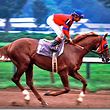 Alydar (March 23, 1975 - November 15, 1990) was a chestnut colt and an American Thoroughbred race horse who was most famous for finishing a close second to Affirmed in all three races of the Triple Crown. With each successive race, Alydar narrowed Affirmed's margin of victory; Affirmed won by 1.5 lengths in the Kentucky Derby, by a neck in the Preakness and by a head in the Belmont Stakes. Alydar has been described as the best horse in the history of Thoroughbred racing never to have won a championship. Alydar's fame continued when he got older, he died under suspicious circumstances. Alydar (March 23, 1975 - November 15, 1990) was a chestnut colt and an American Thoroughbred race horse who was most famous for finishing a close second to Affirmed in all three races of the Triple Crown. With each successive race, Alydar narrowed Affirmed's margin of victory; Affirmed won by 1.5 lengths in the Kentucky Derby, by a neck in the Preakness and by a head in the Belmont Stakes. Alydar has been described as the best horse in the history of Thoroughbred racing never to have won a championship. Alydar's fame continued when he got older, he died under suspicious circumstances.
Racing Career
Trained by John M. Veitch (who also trained Alydar's half-sister, Eclipse Award winning Our Mims) and ridden by jockey Jorge Velásquez, in 1978 Alydar dueled with Affirmed in all three legs of the Triple Crown he lost to his arch-rival by a combined total of less than two lengths. The 1978 Belmont Stakes, the third (and final) leg of the series, is considered by many as one of the most exciting races in the history of the sport. In that race, Alydar and Affirmed dueled side-by-side from the middle of the far turn all the way to the wire, with Affirmed barely holding on to win by a head to claim the Triple Crown.
In his racing career Alydar won 14 of 26 starts, finishing second 9 times and third once, and earned purses totalling $957,195. He raced against Affirmed ten times in his career, winning three. Alydar was inducted into the National Museum of Racing and Hall of Fame in 1989. In the Blood-Horse magazine ranking of the top 100 U.S. thoroughbred champions of the 20th Century, Alydar was ranked #27.
At Stud
Alydar was a major success as a stallion. His offspring include Hall of Fame Eclipse Award Champion Easy Goer; Alysheba, winner of the Kentucky Derby, Preakness Stakes and the Breeders' Cup Classic; Turkoman, Strike the Gold, Criminal Type, Althea, Alydaress, Benchmark, Stella Madrid, and Miss Oceana. He is also the broodmare sire of Peintre Celebre, Cat Thief, Anees, Ajina, Aly's Alley, Gio Ponti, and Lure.
Suspicious Death
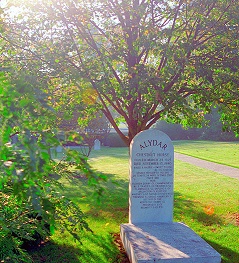 On November 13, 1990, Alydar appeared to have shattered his right hind leg in his stall at Calumet Farms in Lexington, Kentucky. Emergency surgery was performed the next day in an attempt to repair the injury, but the leg broke again. On November 15, Alydar was euthanized. At the time the owner of Calumet Farm was in dire trouble financially, but suspicions of foul play by the management were not raised until federal prosecutors investigated in the late 1990s. John Thomas (J.T.) Lundy was indicted and convicted in 2000 on separate but related fraud charges - bribing a bank executive for favorable loans - and served nearly four years in prison. The farm's former attorney, Gary Matthews, was also convicted and received a 21-month prison sentence. The Texas Monthly described Alydar's death as 'a sweeping saga of greed, fraud, and almost unimaginable cruelty that could have been lifted straight from a best-selling Dick Francis horse-racing novel. Alydar is buried at Calumet Farm.' On November 13, 1990, Alydar appeared to have shattered his right hind leg in his stall at Calumet Farms in Lexington, Kentucky. Emergency surgery was performed the next day in an attempt to repair the injury, but the leg broke again. On November 15, Alydar was euthanized. At the time the owner of Calumet Farm was in dire trouble financially, but suspicions of foul play by the management were not raised until federal prosecutors investigated in the late 1990s. John Thomas (J.T.) Lundy was indicted and convicted in 2000 on separate but related fraud charges - bribing a bank executive for favorable loans - and served nearly four years in prison. The farm's former attorney, Gary Matthews, was also convicted and received a 21-month prison sentence. The Texas Monthly described Alydar's death as 'a sweeping saga of greed, fraud, and almost unimaginable cruelty that could have been lifted straight from a best-selling Dick Francis horse-racing novel. Alydar is buried at Calumet Farm.'
In Houston Federal Court, MIT Professor George Pratt testified that Alydar had to have been killed. He speculated that someone had tied the end of a rope around Alydar's leg and attached the other end of the rope to a truck that could easily have been driven into the stallion barn. The truck then took off, pulling Alydar's leg from underneath him until it snapped; he testified that the force involved was at least three times that which a horse was able to exert. About five days before Alydar's injury his original night watchman, Harold "Cowboy" Kipp, testified that he was at work on the farm when he was ordered to take Tuesday, November 13 off...." Alydar.
Bucephalus
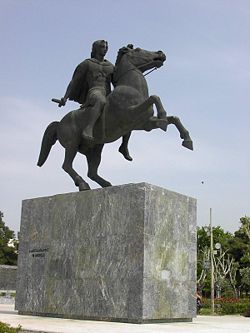
Alexander the Great riding Bucephalus
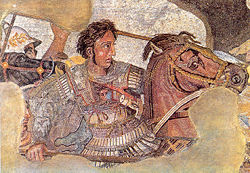
Alexander and Bucephalus in combat at the battle of Issus portrayed in the Alexander Mosaic.
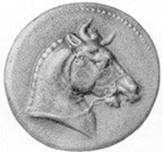
Bucephalus coin
 Bucephalus Bucephalus
Bucephalus or Buchephalas...(c. 355 BC - June, 326 BC) was Alexander the Great's horse and one of the most famous actual horses of antiquity. Ancient accounts state that Bucephalus died after the Battle of the Hydaspes in 326 BC, in what is now modern Pakistan, and is buried in Jalalpur Sharif outside of Jhelum, Pakistan.
The Taming of Bucephalus
A massive creature with a massive head, Bucephalus is described as having a black coat with a large white star on his brow. He is also supposed to have had a "wall," or blue eye, and his breeding was that of the "best Thessalian strain." Plutarch tells the story of how, in 344 BC, a thirteen-year-old Alexander won the horse. Philonicus the Thessalian, a horse dealer, offered the horse to King Philip II for the sum of thirteen talents, but, since no one could tame the animal, Philip was not interested. His son Alexander, however, was, and promised to pay for the horse himself should he fail to tame it. He was given a chance and surprised all by subduing it. He spoke soothingly to the horse and turned it towards the sun so that it could no longer see its own shadow, which had been the cause of its distress. Dropping his fluttering cloak as well, Alexander successfully tamed the horse. Plutarch says that the incident so impressed Philip that he told the boy, "O my son, look thee out a kingdom equal to and worthy of thyself, for Macedonia is too little for thee." Philip's speech strikes the only false note in the anecdote, according to AR Anderson, who noted his words as the embryo of the legend fully developed in the History of Alexander the Great I.15, 17.
The Alexander Romance presents a mythic variant of Bucephalus's origin. In this tale, the colt, whose heroic attributes surpassed even those of Pegasus, is bred and presented to Philip on his own estates. The mythic attributes of the animal are further reinforced in the romance by the Delphic Oracle, who tells Philip that the destined king of the world will be the one who rides Bucephalus, a horse with the mark of the ox's head on his haunch.
Alexander and Bucephalus
Alexander and Bucephalus in combat at the battle of Issus portrayed in the Alexander Mosaic.As one of his chargers, Bucephalus served Alexander in numerous battles. His legend fired the imagination of many an artist from the ancient to the modern world. Paintings of Labrum's Alexandrine subjects, including Bucephalus, survive today in the Louvre. One in particular, The Passage of the Granicus, depicts the warhorse battling the difficulties of the steep muddy river banks, biting and kicking his foes.
Like his hero and supposed ancestor Achilles, Alexander felt that his horses were known to excel all others - for they are immortal. Poseidon gave them to my father Peleus, who in his turn gave them to myself.
Arrian states, with Onesicritus as his source, that Bucephalus died at the age of thirty, a good age for a horse even today. Other sources, however, give as the cause of death not old age or weariness, but fatal injuries at the Battle of the Hydaspes (June 326 BC), in which Alexander's army defeated King Porus. Alexander promptly founded a city, Bucephala, in honour of his horse. It lay on the west bank of the Hydaspes river (modern-day Jhelum in Pakistan). The modern-day town of Jalalpur Sharif, outside Jhelum, is said to be where Bucephalus is buried.
The legend of Bucephalus grew in association with that of Alexander, beginning with the fiction that they were born simultaneously: some of the later versions of the Alexander Romance also synchronized the hour of their death. The pair forged a sort of cult in that, after them, it was all but expected of a conqueror that he have a favourite horse. Julius Caesar had one; so too did the eccentric Roman Emperor Caligula, who made a great fuss of his horse Incitatus, holding inane birthday parties for him, riding him while adorned with Alexander's breastplate and planning to make him a consul.
More information on Bucephalus and Alexander the Great can be easily accessed  Alexander the Great.
Alexander the Great.
Top Home
Burmese
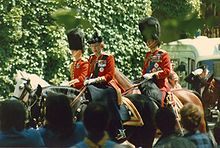
Queen Elizabeth II riding Burmese during Trooping the Colour for the last time in 1986

The Queen on Burmese at Windsor in 1982, during a visit by Ronald Reagan, who was lent the 8-year-old gelding Centenial for the occasion.
Burmese was born at the Royal Canadian Mounted Police Remount Ranch at Fort Walsh, Saskatchewan. She was trained in Ottawa and in 1969 was presented to the Queen when members of the Royal Canadian Mounted Police came to the UK to perform in the Royal Windsor Horse Show. Burmese was born in 1962 and died in 1990. She was a black RCMP Police Serice Horse (PSH) and was given to Queen Elizabeth II by the Royal Canadian Mounted Police. Burmese was ridden by the Queen for Trooping the colour for eighteen consecutive years--1969-1986.
After her last Trooping the Colour parade in 1986, the Queen began riding in a carriage for the ceremony instead of mounting a new charger. For the Queen's Golden Jubilee, the Goverment of Saskatchewan commissioned a statue of the Queen riding Burmese, which was unveiled in 2005.
Top Home
Buttermilk

Buttermilk (died in 1972), Dale Evans' Horse
Buttermilk (1941-1972) was a buckskin Quarter Horse. He appeared in numerous Western films with his owner/rider, cowgirl star Dale Evans.
Buttermilk was ridden by Evans in the 1950s television series The Roy Rogers Show with her husband Roy Rogers who rode his Palomino, Trigger. Both horses were extremely popular and became a marketing success with cast iron and plastic replicas, lamps, and dozens of other products purchased by adults and children. After Buttermilk died in 1972, his hide was stretched over a plaster likeness and put on display at the Roy Rogers and Dale Evans Museum in Victorville, California (the museum has since been relocated to Branson, Missouri). In 2010 the Branson museum was closed and all artifacts were sold including the Trigger and Buttermilk horses. Buttermilk 
Top Home
Dan Patch
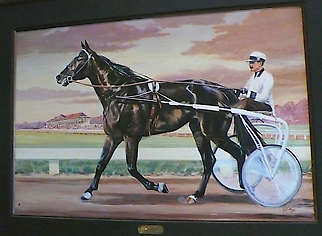
Dan Patch Harness Horse
The Indiana History Society 
Top Home
Justify
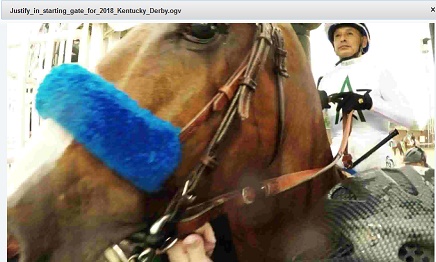
Justify in the starting gate at the 2018 Kentucky Derby
Justify Race Horse/Triple Crown Winner 2018
Top Home
Lexington
Encyclopedia Smithsonian
Accession No. 121040
Catalogue No. 16020 (entry in cat., Nov. 7, 1878)
 The famous race horse, Lexington, was born in 1850, stood 15 hands (63 inches), 3 inches high, and on April 2, 1855, set a record at the Metaire Course in New Orleans by running 4 miles in 7 minutes, 19 3/4 seconds. Perhaps his greatest fame was as sire to numerous brood mares and successful racers, one of whom was Preakness, namesake of the classic race at Pimlico.
The famous race horse, Lexington, was born in 1850, stood 15 hands (63 inches), 3 inches high, and on April 2, 1855, set a record at the Metaire Course in New Orleans by running 4 miles in 7 minutes, 19 3/4 seconds. Perhaps his greatest fame was as sire to numerous brood mares and successful racers, one of whom was Preakness, namesake of the classic race at Pimlico.
Lexington died July 1, 1875, at Woodburn Farm, Woodford County, Kentucky and in keeping with his status, was buried in a coffin in front of the stables housing his harem. Finally, in 1878, his owner, A.J. Alexander, through the auspices of Dr. J.M. Toner, donated the horse's bones to the United States National Museum. Professor N.A. Ward of Rochester, New York, was asked by the Museum to supervise the disinterment and prepare the skeleton for exhibit. Currently, the articulated skeleton can be seen on display in the On Time exhibit at the National Museum of American History, Behring Center.
One of his wins was the Phoenix Hotel Handicap in 1875. Even with his complex and hard-fought rivalry with the horse Lecomte (also a son of Boston, both born just after Boston Lexington (March 17, 1850 - July 1, 1875) was a United States champion Thoroughbred race horse who became the most successful sire during the second half of the nineteenth century.
More on Lexington below:
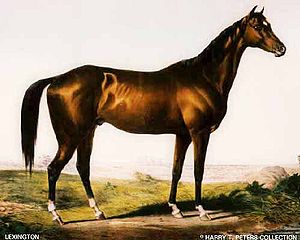
Lexington, the Blind Hero of Woodburn
 Lexington Lexington
Lexington (March 17, 1850 - July 1, 1875) was a United States champion Thoroughbred race horse who became the most successful sire during the second half of the nineteenth century.
A blood bay colt sired by Hall of Famer Boston (by Timoleon by Sir Archy) from the mare Alice Carneal by Sarpedon, eventually reaching 15 hands 3 inches, for his breeder, Dr. Elisha Warfield. Under the name of "Darley" he easily won his first two races for Dr. Warfield and his partner, "Burbridge's Harry," a once slave and then well known horse trainer. Burbridge, being black, was not allowed to enter "Darley" in races in his own name, so the horse ran in Dr. Warfield's name and colors. ("The Spell of the Turf" by Samuel C. Hildreth and James R. Crowell, J. B. Lippincott & Co., 1926.) He caught the eye of Richard Ten Broeck who asked Dr. Warfield to name his price. "Darley," the son of Boston, was sold in 1853 to Ten Broeck acting on behalf of a syndicate who would rename him Lexington. Affixed to Lexington's pedigree Dr. Warfield wrote: "The colt was bred by me, as was also his dam, which I now and will ever, own...E. Warfield."
A syndicate made up of Richard Ten Broeck, General Abe Buford, Captain Willa Viley and Junius R. Ward, bought the horse for $2,500 between heats (or during the running of his race), so tried claiming the purse money when he won. Failing that, he tried to deduct the purse money from the sale price. But Dr. Warfield held out.
His new owners immediately sent Lexington to Natchez, Mississippi to train under J. B. Pryor. Lexington raced at age three and four and although he only competed seven times, many of his races were grueling four-mile events. Lexington won six of his seven races and finished second once. One of his wins was the Phoenix Hotel Handicap in 1875. Even with his complex and hard-fought rivalry with the horse Lecomte (also a son of Boston, both born just after Boston died), he was known as the best race horse of his day. His second match with Lecomte on April 24, 1855 was considered one of the greatest matches of the century. But Lexington had to be retired at the end of 1855 as a result of poor eyesight. His sire, Boston, had also gone blind.
He stood for a time at the Nantura Stock Farm of Uncle John Harper in Midway, Kentucky, along with the famous racer and sire, Glencoe. Sold to Robert A. Alexander for $15,000 in 1858, reportedly the then highest price ever paid for an American horse, Lexington was sent to Alexander's Woodburn Stud at Spring Station, Kentucky.
Called "The Blind Hero of Woodburn," Lexington became the Leading sire in North America sixteen times, from 1861 through 1874, and then again in 1876 and 1878. Lexington was the sire of the undefeated Asteroid and Norfolk. Nine of the first fifteen Travers Stakes were won by one of his sons or daughters, a list that included Kentucky (owned by William Travers himself), the first winner in 1864, and one of his last offspring, Duke of Magenta who won the Travers in 1878...as well as the Withers Stakes, the Preakness Stakes, and the Belmont Stakes. Lexington sired three Preakness Stakes winners: Tom Ochiltree (1875), Shirley (1876), and the Duke of Magenta (1878). His three Preakness winners tie him with another great sire, Broomstick. Lexington also sired Cincinnati, General Ulysses S. Grant's favorite horse. Cincinnati was depicted in numerous statues of Grant that remain to this day.
During the American Civil War, horses were forcibly conscripted from the Kentucky Farms to serve as mounts in the bloody fray. Lexington, 15 years old and blind, had to be hidden away to save him from such a fate.
Lexington was part of the first group of horses inducted into the National Museum of Racing and Hall of Fame in 1955. Not so long ago, Lexington was so forgotten that on a fourth-floor attic catwalk of the Smithsonian Institution's National Museum of Natural History, the blind hero of Woodburn was listed simply as Catalog No. 16020.
Lexington's dominance in the pedigrees of American-bred Thoroughbreds, and the fact that the British Thoroughbred breeders considered him not a purebred, was a large factor in the so-called Jersey Act of 1913, where the British Jockey Club limited the registration of horses not traced completely to horses in the General Stud Book. The Belmont Lexington Stakes runs every year at Belmont Park in honor of Lexington, as does the Lexington Stakes at Keeneland Race Course.
 Lexington Lexington
Top Home
Winchester
 General Philip H. Sheridan General Philip H. Sheridan
Accession No. 69413
Catalogue No. 32870
Encyclopedia Smithsonian
General Philip H. Sheridan's horse during most of the Civil War, Winchester was mounted and presented to the Smithsonian in 1923 by the Military Service Institution, Governor's Island, New York. The horse's name, originally "Rienzi," was changed to Winchester after carrying Sheridan on his famous ride from Winchester, Virginia to Cedar Creek, Virginia in time to rally his troops and turn almost-certain defeat into victory.
Winchester can be seen in the Armed Forces History Hall at the Smithsonian's National Museum of American History, Behring Center.
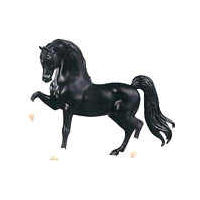 Winchester was Union Army Gen. Philip Sheridan's mount during the Civil War. Originally named Rienzi, this black Morgan with three white stockings, was renamed Winchester for the town from which General Sheridan started his famous ride during the Battle of Cedar Creek. While attending a meeting, Sheridan learned that the Confederate Army had attacked and routed the union Army at Cedar Creek. Union losses had been significant that year and Sheridan feared that another loss might cost President Lincoln the election of 1864. So, he set out from Winchester to try to rally the retreating Union troops. Winchester and Sheridan galloped many miles that day, rallying the retreating Union Army, an effort which eventually won the battle and then the war.
Winchester was Union Army Gen. Philip Sheridan's mount during the Civil War. Originally named Rienzi, this black Morgan with three white stockings, was renamed Winchester for the town from which General Sheridan started his famous ride during the Battle of Cedar Creek. While attending a meeting, Sheridan learned that the Confederate Army had attacked and routed the union Army at Cedar Creek. Union losses had been significant that year and Sheridan feared that another loss might cost President Lincoln the election of 1864. So, he set out from Winchester to try to rally the retreating Union troops. Winchester and Sheridan galloped many miles that day, rallying the retreating Union Army, an effort which eventually won the battle and then the war.
Winchester is preserved and on display at the Smithsonian National Museum of American History. My family visited this Christmas week (2009) and were quite surprised to see Winchester's size. He was quite large, especially for a Morgan. Although Winchester is encased in glass, which makes it difficult to get good pictures, below are some that my daughter took for my website (at my urging!) along with the accompanying signage: (I will try to get another picture of the signage, but the flash reflection is a problem. So temporarily this will remain.)
The horse's name, originally "Rienzi," was changed to Winchester.
Smithsonian National Museum of American History
A close-up of Winchester's head, neck and bridle. Lots of leverage in the bit!
Winchester's Plaque (signage) at the Smithsonian.
Top Home
Kidron
Encyclopedia Smithsonian
Accession No. 164991
Catalogue No. 270900
Kidron became famous as General of the Armies John J. ("Black Jack") Pershing's horse. Historic photographs show Pershing riding Kidron triumphantly through the Victory Arch in New York City at the end of World War I.
The horse died October 10, 1942, in Front Royal, Virginia. Hoping to have the horse mounted, the War Department, Front Royal Quartermaster Depot, Remount of Front Royal, Virginia, turned over the remains to the U.S. National Museum. However, because of Kidron's age at the time of his death and because the body had decomposed rapidly due to hot weather, taxidermists were unable to mount the skin.
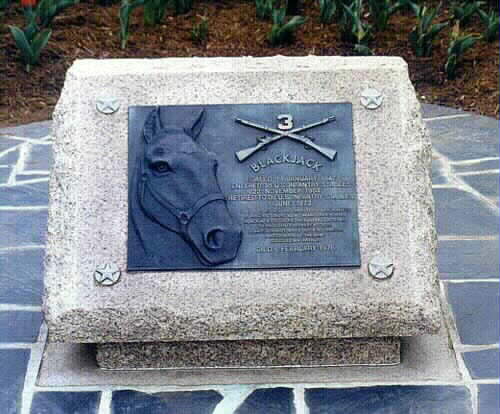 On March 31, 1943, the Office of the Registrar at the Smithsonian accepted as a transfer from the War Department, the skin and skull of Kidron. These remains are now part of the research collection of the Division of Mammals in the National Museum of Natural History.
On March 31, 1943, the Office of the Registrar at the Smithsonian accepted as a transfer from the War Department, the skin and skull of Kidron. These remains are now part of the research collection of the Division of Mammals in the National Museum of Natural History.
Blackjack, the last of the United States Army Quartermaster issued horses, was born on 19 January 1947. He entered the Third United States Infantry Stables at Fort Myer on 22 November 1953.
During his service as a caparisoned (riderless horse), Blackjack took part in the funerals of Presidents Herbert Hoover, John F. Kennedy and Lyndon B. Johnson and that of the General of the Army Douglas MacArthur. Of course, his service also included literally hundreds of other funeral processions in Arlington National Cemetery.
Blackjack was retired to the Third United States Infantry Stables on 1 June 1973. When he died on 6 February 1976, Blackjack was laid to rest on the parade ground at Fort Myer, Virginia.
Top Home
Haleb
Encyclopedia Smithsonian
Accession No. 52188
Catalogue No. 172454
Also known as the"Pride of the Desert", this Arabian horse beat 19 Morgan horses winning the Justin Morgan Cup in Vermont on June 1907.
He was brown, without white markings, stood 14.2 hands high and weighed 960 pounds. According to his owner, Homer Davenport, the horse was acquired on August 8, 1900, from Nazim Pasha, the governor of Syria and Aleppo, who had received it from the supreme sheik of the Anezeh. The origin of the stallion was cited as Mesopotamia (Anezeh Arabians). He was supposedly bred by the Gomussa tribe of the Sebba Anezeh. His mother was the last of the distinguished Maneghi Sbeyel mares, tracing back more than 500 years, and his sire was a stallion of the family of Sueyman Sebba of the southern desert.
After Haleb's death on November 10, 1909, at the age of 8, his skull and partial skeleton, prepared by Ward's Natural Science Establishment in Rochester, New York, were donated to the Smithsonian by Davenport. The Division of Mammals assigned a catalogue number to the specimen on December 9, 1910, and placed it in the research collection.
Top Home
Old Henry Clay
Encyclopedia Smithsonian
Accession No. 10191
Catalogue No. 21876
Old Henry Clay, often called "America's National Thoroughbred Trotting Horse" or "Father of American Trotting Horses," was foaled on Long Island in 1837 and purchased by Colonel William W. Wadsworth of Seneso, Livingston County, New York. When his days as a famous trotting horse were over, he was used for breeding and finally died at Lodi, New York in the spring of 1867. In life the horse stood 15 1/4 hands high. (61 inches)
Some 14 years after his burial, Old Henry Clay's bones were dug up and his skeleton mounted by Ward's Natural Science Establishment in Rochester, New York. The skeleton was donated to the United States National Museum on April 22, 1881, by the Honorable Erastus Corning and Henry C. Jewett through the auspices of Randolph Huntington.
Only the mandible, a part of the skull, remains as a remnant of Old Henry Clay. It is kept in the research collection at the Smithsonian's Museum Support Center in Suitland, Maryland.
Top Home
Sysonby
Encyclopedia Smithsonian
AMNH No. 204061
Chubb No. 61
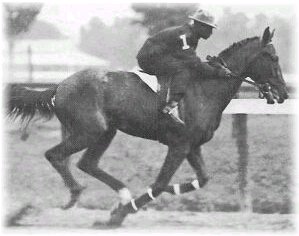 The American Museum of Natural History in New York City (which is not part of the Smithsonian Institution) is home for the skeleton of famous racehorse Sysonby. From 1904, as a two-year old, to 1906, his series of victories assured him a place in racehorse history. The horse died June 1906 at the age of 4 years and 4 months, and his remains were donated to the Museum in July of that year by James R. Keene. Funds for the skeletal preparation were also provided. In 1908, S. Harmsted Chubb, anatomist and research associate at the Museum, mounted the skeleton to demonstrate a phase in the stride of a running horse. The Chubb series of skeletons are famous as studies in anatomy and locomotion. Currently, Sysonby is in the storage area of the Museum with other horses of the Chubb Collection. The American Museum of Natural History in New York City (which is not part of the Smithsonian Institution) is home for the skeleton of famous racehorse Sysonby. From 1904, as a two-year old, to 1906, his series of victories assured him a place in racehorse history. The horse died June 1906 at the age of 4 years and 4 months, and his remains were donated to the Museum in July of that year by James R. Keene. Funds for the skeletal preparation were also provided. In 1908, S. Harmsted Chubb, anatomist and research associate at the Museum, mounted the skeleton to demonstrate a phase in the stride of a running horse. The Chubb series of skeletons are famous as studies in anatomy and locomotion. Currently, Sysonby is in the storage area of the Museum with other horses of the Chubb Collection.
Groom Ernest Shackleford described Sysonby as "a common, cheap-looking, lop-eared colt that stood only 15.1 hands as a three-year-old." Yet his legendary name, derived from that of a hunting lodge, dominates early twentieth century racing history. Horsemen who witnessed his career spoke of Sysonby in tones of awe. Some named the champion as the best they ever saw, ranking him above even Man o' War.
Information on Sysonby, courtesy of the Department of Mammalogy, American Museum of Natural History, New York, N.Y.
Top Home
Hanover
 Hanover Hanover
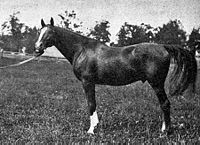
Hanover from the 1906 Types and Breeds of Farm Animals
Hanover (1884-1899) was a champion American thoroughbred racehorse.
Living with the Dwyer Boys
Bred at Colonel E. Clay's Runnymede Farm, the thoroughbred chestnut colt was sired by Hindoo from the mare Bourbon Belle. At the farm's yearling sale in May of 1885, Hanover was sold to the Dwyer Brothers Stable for $1,250. Hanover now lived under the same roof as Tremont, also born in 1884, and considered the better horse. Hanover was lazy. He was also so easy-going he often seemed half asleep. Tremont, meanwhile, was everyone's idea of a racehorse. In a yearling trial, Tremont ran a quarter mile in :22 1/2 seconds. Yet in a workout, Hanover beat Tremont.
Trained by Frank McCabe, at age two, Hanover won all three races he entered: the Hopeful, the July, and the Sapling Stakes. Meanwhile, the two-year-old Tremont started 13 times in the space of 10 weeks and won every race. Notorious for over-racing their horses, the Dwyer brothers ruined Tremont by running him so hard and so often.
Hanover's Turn
With Tremont side-lined, the Dwyers turned to Hanover to take over the task of earning the big money for the Dwyer Stable. They entered Hanover in twenty-seven races at the age of three, races of all distances, including the Belmont Stakes which he won by fifteen lengths. In his first two years of racing, Hanover frequently went up against older horses but still won seventeen straight events and wound up his racing career at age five with a record of 32-14-2 in 50 starts.
Like Tremont, Hanover's feet were ruined by this treatment. To keep him racing, the Dwyers had his bad foot "nerved" to deaden the pain. This means they removed the nerve from his foot. This is how he raced at age five. When he finally became lame, as well as exhausted, they retired him. Hanover stopped racing as the USA's greatest earner with a career total of $118,887.
A Stallion With Sore Feet
At stud, Hanover was also very successful and was the leading sire in the United States for four consecutive years. His offspring includes the Hall of Fame colt Hamburg, as well as David Garrick, Halma, Handspring, Half Time, and Yankee. He topped the US sire list from 1885 to 1898.
But as a stallion in his stall, Hanover fell ill and his food was cut back. Hanover, furious, began to stamp his feet to demand more food. Not being able to feel pain in his "unnerved" forefoot, he broke the coffin bone. Before anyone noticed, blood poisoning had set in and become systemic. He was put down 1n 1899.
Following creation of the National Museum of Racing and Hall of Fame, Hanover was part of the first group of horses inducted in 1955.
The skeleton of Hanover is at the University of Kentucky in Lexington.
Top Home
Traveller
 Traveller Traveller  Robert E. Lee Robert E. Lee
Traveller, famous as General Robert E. Lee's horse, died in 1872, two years after Lee. Initially the horse was buried, but in response to numerous requests, it was disinterred and the skeleton mounted and displayed at Washington and Lee University in Lexington, Virginia. After more than 60 years on exhibit, on May 8, 1971, the horse was reburied outside the Lee Chapel at the University close to the Lee family crypt.
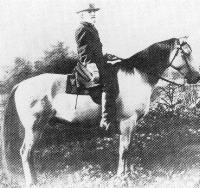
Traveller was the war horse of General Robert E. Lee. Traveller was ridden by General Lee thoughout most of the Civil War. The iron grey horse was born in 1857 in Greenbrier County, in what is now West Virginia. He was first named Jeff Davis by Andrew Johnston, who bred him. He was renamed Greenbrier by the next owner, Captain Joseph M. Broun. Lee bought the gelding from Capt. Broun for $200 in 1861 and renamed him Traveller. The horse weighed around eleven hundred pounds and stood 15.3 hands high. He was not only iron grey in color, but iron in constitution, and was Lee's favorite mount. The horse was steady no matter how fierce the noise of battle or the crush of fighting, surefooted with great stamina, and had easy gaits to ride. Some think the horse was an ambler (like a Tennessee Walking Horse), but no facts exist to prove that. His conformation does seem to resemble the Plantation Horse, which had an ambling gait. General Lee gave Traveller a rest now and then and rode other horses, but Traveller was always his favorite mount.
In 1870, after General Lee died of a heart attack, Traveller was led behind the General's hearse. He outlived General Lee, but only for a short time. Not long after Lee's death, Traveller stepped on a rusty nail and developed lockjaw. There was no cure, and he was shot to relieve his suffering. Traveller was only 13 years old. He was buried next to the Lee Chapel. In 1907 his remains were disinterred and displayed at the Chapel for a while before being reburied outside the Lee Chapel.
Top Home
Comanche
 Comanche Comanche
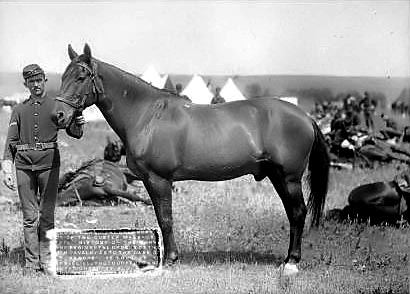
Defeat rather than victory brought fame to Comanche. He was known as the sole survivor of General George Custer's command at the Battle of the Little Bighorn on June 25, 1876.
Of mustang lineage, he was born about 1862, captured in a wild horse roundup, gelded and sold to the U.S. Army Cavalry on April 3, 1868, for $90. The bay, 925 pounds, standing 15 hands high with a small white star on his forehead, became the favorite mount for Captain Myles Keogh of the 7th Cavalry. He participated in frequent actions of the Regiment and sustained some 12 wounds as a result of these skirmishes.
Two days after the Custer defeat, a burial party investigating the site found the severely wounded horse and transported him by steamer to Fort Lincoln, 950 miles away, where he spent the next year recuperating. Comanche remained here with the 7th Cavalry, never again to be ridden and under orders excusing him from all duties. Most of the time he freely roamed the Post and flower gardens. Only at formal regimental functions was he led, draped in black, stirrups and boots reversed, at the head of the Regiment.
When the Cavalry was ordered to Fort Riley, Kansas, in 1888, Comanche, aging but still in good health, accompanied them and continued to receive full honors as a symbol of the tragedy at Little Bighorn. Finally, on November 7, 1891, about 29 years old, Comanche died of colic.
The officers of the 7th Cavalry, wanting to preserve the horse, asked Lewis Lindsay Dyche of the University of Kansas to mount the remains: skin and major bones. For a fee of $400 and on condition that he be permitted to show the horse in the Chicago Exposition of 1893, Dyche completed the appropriate taxidermy. Although there is no record of the fee being paid, the horse was donated to the university's Museum and property rights are vested in the University through L.L. Dyche. Comanche is currently on display in a humidity controlled glass case at the University of Kansas Museum of Natural History, Dyche Hall, Lawrence, Kansas.
Information on Comanche, courtesy of the University of Kansas Museum of Natural History Lawrence, Kansas.
Top Home
Little Sorrel
Encyclopedia Smithsonian
 Stonewall Jackson Stonewall Jackson
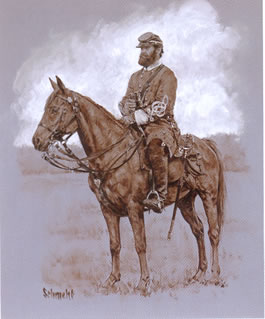
Little Sorrel, or "Fancy" as he was known, became famous as the mount of General Stonewall Jackson. Captured at Harpers Ferry by the Confederates, he was chosen initially for Mrs. Jackson but eventually commandeered by the General when his own horse, Big Sorrel, proved unreliable in battle. In 1863, at Chancellorsville, Jackson, while riding the horse, was wounded by his own men and died a few days later. At first Little Sorrel was pastured at Mrs. Jackson's home in North Carolina, later sent as a mascot to the Virginia Military Institute where the General had taught cadets he led to battle, and then in response to requests from many Southern States, was shown at fairs and exhibitions.
In 1885, ancient and infirm at the age of 35, he was retired to the Confederate Soldier's Home. The following year he died when the hoist used to lift him to his feet slipped; he fell breaking his back. Little Sorrel was stuffed and housed in a museum at the Veterans Home until 1949 when he was finally returned to V.M.I. Refurbished twice since 1886, Little Sorrel is presently on display at the Virginia Military Institute's Museum in Lexington, Virginia.
Top Home
Trigger
Encyclopedia Smithsonian
 Trigger Trigger
 Roy Rogers Roy Rogers
 Palomino (Trigger's color) Palomino (Trigger's color)
 Tonto Tonto
Questions and Answers
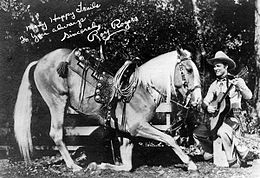 Neither a racehorse nor the mount of a famous general, Trigger, owned by movie star cowboy Roy Rogers, brought pleasure and excitement to countless motion picture patrons. The golden palomino stallion appeared in all of Rogers' 90 feature films and 101 television shows. According to his owner, "He had great rein and could spin on a dime." Inheriting the best characteristics of his sire, a thoroughbred racehorse, and his dam, a golden palomino, Trigger had stamina, beauty, intelligence, and a remarkably gentle disposition. On July 3, 1965, at the Rogers ranch in Hidden Valley, California, Trigger, 33, succumbed to old age. Reluctant to "put him in the ground," Rogers had the horse mounted in a rearing position by Bishoff's Taxidermy of California. Trigger, in full regalia - bridle, saddle, and martingale - is presently on exhibit at the Roy Rogers - Dale Evans Museum in Branson, Missouri, the repository for the Rogers memorabilia. Neither a racehorse nor the mount of a famous general, Trigger, owned by movie star cowboy Roy Rogers, brought pleasure and excitement to countless motion picture patrons. The golden palomino stallion appeared in all of Rogers' 90 feature films and 101 television shows. According to his owner, "He had great rein and could spin on a dime." Inheriting the best characteristics of his sire, a thoroughbred racehorse, and his dam, a golden palomino, Trigger had stamina, beauty, intelligence, and a remarkably gentle disposition. On July 3, 1965, at the Rogers ranch in Hidden Valley, California, Trigger, 33, succumbed to old age. Reluctant to "put him in the ground," Rogers had the horse mounted in a rearing position by Bishoff's Taxidermy of California. Trigger, in full regalia - bridle, saddle, and martingale - is presently on exhibit at the Roy Rogers - Dale Evans Museum in Branson, Missouri, the repository for the Rogers memorabilia.
Prepared by the Department of Systematic Biology, Vertebrate Zoology Section, National Museum of Natural History, in cooperation with the Public Inquiry Mail Service, Smithsonian Institution.
Top Home
Man O' War
 Man O' War Man O' War
Born: March 29, 1917, at Nursery Stud, Lexington, Kentucky
Died: November 1, 1947 (age 30), at Faraway Farm, buried at the Kentucky Horse Park, Lexington, Kentucky
 Man O' War is a name that is recognized by all ages and will continue to be through the ages. He is timeless and appreciated by all-- horse lover or not. He is considered the most famous horse race of all time. Man O' War was foaled on March 29, 1917 out of the mare Muhubah. August Belomt II was the breeder. Man O'War was sold at Saratoga Yearling Sale for $5,000. With war looming Belmont was called to serve his country.
Man O' War is a name that is recognized by all ages and will continue to be through the ages. He is timeless and appreciated by all-- horse lover or not. He is considered the most famous horse race of all time. Man O' War was foaled on March 29, 1917 out of the mare Muhubah. August Belomt II was the breeder. Man O'War was sold at Saratoga Yearling Sale for $5,000. With war looming Belmont was called to serve his country.
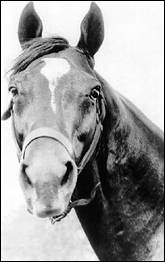
Louis Feustal, a trainer who had knowledge of Man O'War's sire and grandsire, urged Samuel Riddle to buy the colt. This was a lucky day for Mr. Feustal. Man O' War made his racing debut in a Maiden 6F race against 6 others. He won by 6 lengths. Three days later he made his stakes debut in the Keene Memorial for 2 year olds. H won against 6 other entries.
Eleven days later Man O' War then raced in the Youthful Stakes at Jamaica Park. Two days leter he went to Aqueduct where he entered into the Hudson Stakes. He carried 130 pounds in the Hudson. That is a tremendous amount of weight for a young horse. He won. The second horse trailed by 2 1/2 lengths, and carried only 21 pounds. Man O'War went on to win the Tremont Stakes. In this race he carried 130 pounds. He then went to Saratoga and won the United States Hotel Stakes, defeating Upset by 1 length. Upset was carrying only 115 lbs.

August 13, 1919, Saratoga, The Sanford Memorial-- Man O' War was racing against Golden Broom with equal weight. History shows that this was a controversial race. In fact, Saratoga would become to known as "the house of upsets" and "graveyard of favorites". Man O'War was to race against Golden Broom at level weights. At the time, Upset was also in the race. He was not considered a threat because Man O' War had raced him and won in the past carrying much more weight. In the 1900's at the call to post there was no starting gate as there is today. The horses would circle around and line up at a starting line. Then the flag would go down signaling the beginning of the race. At this race Man O' War was still circling not facing the track. His jockey, Johnny Loftus, realized what had happened and Man O' War did not understand why the field was racing away. The race was a short one; only 6 furlongs. Even with a noble attempt there was not time to make up the ground. Man O' War lost the race to Upset. In spite of this win Man O' War was considered by most to be the best horse. The mistake was blamed on the jockey, Mr. Loftus. In fact, the jockey's license was denied for the next year. The speculation was that Sanford was fixed. Once again, ten days later, at the Grand Union Hotel Stakes, Man O' War triumphed over Upset. He won by four lengths.
Man O'War did not race in the Kentucky Derby and Paul Jones took the honors. Man O'War beat Upset by 1 1/2 lengths at the Preaknes. Man O'War raced in the Witihers under 118 pounds of weight. He won the race setting a new American record for one mile. (1:35 4/5) The Belmont Stades was next--he won by 20 lengths setting a new American record for 1 3/8 mile. (2:14 1/5) He then raced against Yellowhand winning by 8 lengths at the Stuyvesant Handicap.
Man O' War's wins continued. His next race was the Dwyer at Aqueduct. He beat John P. Grier by 1 1/2 lengths. Once again Man O' War set another Amnerican record of 1:49 1/5. Big Red was sent against the clock in the Lawrence Realization. Only one horse came up, Hoodwink. Feustal knowing there was no challenge, let him run. The 1 5/8 mile record was 2:45 flat. Man O'War won the race by an estimated 100 lengths in a new American time of 2:40 4/5. It was said he "won by a mile"but the officials did not speak in the language and rounded it to 100.
Man O'War went on to win the 1 1/2 mile Jockey Club Stakes in an American record of 2:28 4/5. He won the Potomac Handicap. He bowed a tendon in this race and would race just one more time. Man O'War's final start was against an older horse, Sir Barton, in the 1 1/4 mile Kenilworth Park Gold Cup. In this race Man O'War carried only 120 lbs to Sir Bartons 126. Man O' War won by 7 lengths. (At that time, Match races were not allowed so another horse was entered in the race, but scratched before post time.) However, it was said after the race that Sir Barton had had sore feet. After the race rumours were flying. The owner of Exterminator had been offended for not being invited to the race. Earl Sande was replaced by Frank Keogh for the ride on Sir Barton just a few minutes before post. Fuestal had found out that someone had tried to slice Man O'War's stirrup leather. But fortunatly it had held up. However, Fuestal realized the threat facing Man O' War if he continued to race.
There were many match race offers. All were declined. On January 7, 1921, Man O' War was ridden under silks at the Lexington Association Track.
He died quietly on November 1, 1947 at the age of 30. Man O' War was eventually moved to the Kentucky Horse Park, where the original burial site was recreated. More than 50 years after his death, he still attracts thousands of visitors anually. And in the words of Will Harbut, Red's groom, he is still the "mostest hoss."
Top Home
Phar Lap
 Phar Lap Phar Lap
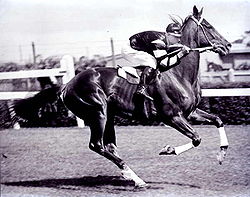
Phar Lap with jockey Jim Pike at Flemington Racecourse c 1930

Sire Night Raid (GB)
Grandsire Radium (GB
Dam Entreaty (NZ)
Damsire Winkie (GB)
Sex Gelding
Foaled 1926
Country New Zealand
Color Chestnut
Breeder Alick Roberts
Owner David Davis and Harry Telford
Trainer Harry Telford
Record 51:37-3-2
Earnings A66,738 pounds
Major wins
AJC Derby (1929)
Victoria Derby (1929)
Linlithgow Stakes (1930)
Futurity Stakes (1930)
Melbourne Cup (1930)
Chipping Norton Stakes (1930)
Cox Plate (1930 & 1931)
Melbourne Stakes (1930 " 1931)
Underwood Stakes (1931)
Agua Caliente Handicap (1932)
Honors
#22 - Top 100 U.S. Racehorses of the 20th Century
1983 Motion Picture - Phar Lap: Heart of a Nation
Australian Racing Hall of Fame
New Zealand Racing Hall of Fame
Phar Lap (1926-1932) was a champion Thoroughbred racehorse whose achievements captured the public's imagination during the early years of the Great Depression. Foaled in New Zealand, he was trained and raced in Australia. Phar Lap dominated Australian racing during a distinguished career, winning a Melbourne Cup, two Cox Plates and 19 other weight for age races. He then won the Agua Caliente Handicap in Tijuana, Mexico in track-record time in his final race. After a sudden and mysterious illness, Phar Lap died in 1932. At the time, he was the third highest stakes-winner in the world. His mounted hide is displayed at the Melbourne Museum, his skeleton at Museum of New Zealand Te Papa Tongarewa and his heart at the National Museum of Australia in Canberra.
Name
The name Phar Lap derives from the shared Zhuang language and Thai word for lightning: ...'sky flash.'
Phar Lap was called the "Wonder Horse," "Red Terror," "Bobby" and "Big Red" (the latter nickname was also given to two of the greatest US racehorses, Man o' War and Secretariat). He was sometimes referred as "Australia's wonder horse."
According to the Museum Victoria, Aubrey Ping, a student at the University of Sydney, suggested "farlap" as the horse's name. Telford liked the name, but changed the F to PH to create a seven letter word, which was split in two in keeping with the dominant naming pattern of Melbourne Cup winners.
Early Life
A chestnut gelding, Phar Lap was foaled on 4 October 1926 in Seadown near Timaru in the South Island of New Zealand. He was sired by Night Raid from Entreaty by Winkie. He was by the same sire as the Melbourne Cup winner Nightmarch.
Sydney trainer Harry Telford persuaded American businessman David J. Davis to buy the colt at auction, based on his pedigree. Telford's brother Hugh, who lived in New Zealand, was asked to bid up to 190 guineas at the 1928 Trentham Yearling Sales. When the horse was obtained for a mere 160 guineas, he thought it was a great bargain until the colt arrived in Australia. The horse was gangly, his face was covered with warts, and he had an awkward gait. Davis was furious when he saw the colt as well, and refused to pay to train the horse. Telford had not been particularly successful as a trainer, and Davis was one of his few remaining owners. To placate Davis, he agreed to train the horse for nothing, in exchange for a two-thirds share of any winnings. Telford leased the horse for three years and was eventually sold joint ownership by Davis.
Although standing a winning racehorse at stud could be quite lucrative, Telford gelded Phar Lap anyway, hoping the colt would concentrate on racing.
Phar Lap finished last in the first race and did not place in his next three races. He won his first race on 27 April 1929, the Maiden Juvenile Handicap (maiden = a race for horses that had previously not won a race) at Rosehill, ridden by Jack Baker of Armidale, a 17-year-old apprentice. He didn't race for several months but was then entered in a series of races, in which he moved up in class. Phar Lap took second in the Chelmsford Stakes at Randwick on 14 September 1929 and the racing community started treating him with respect.
As his achievements grew, there were some who tried to halt his progress. Criminals tried to shoot Phar Lap on the morning of Saturday 1 November 1930 after he had finished track work. They missed, and later that day he won the Melbourne Stakes, and three days later the Melbourne Cup as odds-on favourite at 8 to 11.
Racing Life
In the four years of his racing career, Phar Lap won 37 of 51 races he entered, including the Melbourne Cup in 1930 with 9st 12 lb (61.5 kg, or 138 lbs). In that year and 1931, he won 14 races in a row. From his win as a three-year-old in the VRC St. Leger Stakes until his final race in Mexico, Phar Lap won 32 of 35 races. In the three races that he did not win, he ran second on two occasions, beaten by a short head and a neck, and in the 1931 Melbourne Cup he finished eighth when carrying 10 st 10 lb (68 kg).
Phar Lap at the time was owned by American businessman David J. Davis and leased to Telford. After their three year lease agreement ended, Telford had enough money to become joint owner of the horse. Davis then had Phar Lap shipped to America in order to race. Telford did not agree with this decision and refused to go, so Davis sent Tom Woodcock. Phar Lap was shipped by boat to Agua Caliente Racetrack near Tijuana, Mexico, to compete in the Agua Caliente Handicap, which was offering the largest purse ever raced for in North America. Phar Lap won in track-record time while carrying 129 pounds (58.5 kg) and was ridden by Billy Elliot for his seventh win from seven rides. From there, the horse was sent to a private ranch near Menlo Park, California, while his owner negotiated with racetrack officials for special race appearances.
Death
Early on 5 April 1932, the horse's strapper for the North American visit, Tommy Woodcock, found him in severe pain and having a high temperature. Within a few hours, Phar Lap hemorrhaged to death. Much speculation ensued, and when a necropsy revealed that the horse's stomach and intestines were inflamed, many believed the horse had been deliberately poisoned. There have been alternative theories, including accidental poisoning from lead insecticide and a stomach condition. It was not until the 1980s that the infection could be formally identified. In 2000, equine specialists studying the two necropsies concluded that Phar Lap probably died of duodenitis-proximal jejunitis, an acute bacterial gastroenteritis. However, in 2006 Australian Synchrotron Research scientists said it was almost certain Phar Lap was poisoned with a large single dose of arsenic in the hours before he died, perhaps supporting the theory that Phar Lap was killed on the orders of U.S. gangsters, who feared the Melbourne-Cup-winning champion would inflict big losses on their illegal bookmakers. No real evidence of involvement by a criminal element exists, however.
Sydney veterinarian, Dr Percy Sykes, believes poisoning did not cause the death. He said "In those days, arsenic was quite a common tonic, usually given in the form of a solution (Fowler's Solution)," and suggests this was the cause of the high levels. "It was so common that I'd reckon 90 per cent of the horses had arsenic in their system." In December 2007 Phar Lap's mane was tested to find if he was given repeated doses of arsenic which, if found, would point to accidental poisoning.
On 19 June 2008, the Melbourne Museum released the findings of the forensic investigation conducted by Dr. Ivan Kempson, University of South Australia, and Dermot Henry, Natural Science Collections at Museum Victoria. Dr. Kempson took six hairs from Phar Lap's mane and analyzed them at the Advanced Photon Source in Chicago. These high resolution x-rays detect arsenic in hair samples, showing the specific difference "between arsenic, which had entered the hair cells via the blood and arsenic, which had infused the hair cells by the taxidermy process when he was stuffed and mounted at the museum."
Kempson and Henry discovered that in the 30 to 40 hours before Phar Lap's death, the horse ingested a massive dose of arsenic. "We can't speculate where the arsenic came from, but it was easily accessible at the time," Henry said.
Following his death, Phar Lap's heart was donated to the Institute of Anatomy in Canberra and his skeleton to the New Zealand's National Museum in Wellington. After preparations of the hide by a New York City taxidermist, his stuffed body was placed in the Australia Gallery at Melbourne Museum.
Phar Lap's heart was remarkable for its size, weighing 6.2 kg, compared with a normal horse's heart at 3.2 kg. Now held at the National Museum of Australia in Canberra, it is the object visitors most often request to see.
Cultural Impact
Several books and films have been written about the horse, including the 1983 movie Phar Lap or Phar Lap: Heart of a Nation. A song, "Phar Lap-Farewell To You," was also written.
Lap was one of five inaugural inductees into the both the Australian Racing Hall of Fame and New Zealand Racing Hall of Fame. In the Blood-Horse magazine ranking of the Top 100 U.S. Thoroughbred champions of the 20th century, Phar Lap was ranked No. 22.
The horse is considered to be a national icon in both Australia and New Zealand. In 1978 he was honored on a postage stamp issued by Australia Post. Phar Lap Software, Inc. was named after the horse. A $500,000 life-sized bronze memorial to Phar Lap is being created at Timaru and will be unveiled on 25 November 2009 near Phar Lap's birthplace. The horse features in the Australian citizenship test.
Top Home
Reckless

Reckless War Horse aka Recoilless and Reckless Rifles
The Statue Dedication at Quantico, VA
Top Home
Scout
Scout
The Lone Ranger and Tonto
Questions and Answers
Top Home
Seabiscuit
 Seabiscuit Seabiscuit
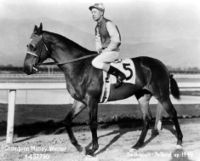 Seabiscuit (May 23, 1933-May 17, 1947) was a champion thoroughbred race horse in the United States. From an inauspicious start, Seabiscuit became an unlikely champion and a symbol of hope to many Americans during the Great Depression. Seabiscuit became the subject of a 2001 book (Seabiscuit: An American Legend), a 1949 film, The Story of Seabiscuit, and a more recent 2003 film (Seabiscuit) which was nominated for the Academy Award for Best Picture, losing out to The Lord of the Rings: The Return of the King.
Seabiscuit (May 23, 1933-May 17, 1947) was a champion thoroughbred race horse in the United States. From an inauspicious start, Seabiscuit became an unlikely champion and a symbol of hope to many Americans during the Great Depression. Seabiscuit became the subject of a 2001 book (Seabiscuit: An American Legend), a 1949 film, The Story of Seabiscuit, and a more recent 2003 film (Seabiscuit) which was nominated for the Academy Award for Best Picture, losing out to The Lord of the Rings: The Return of the King.
Early days
Seabiscuit was born from the mare Swing On and sired by Hard Tack (son of Man O' War). The son was named for the father; the word seabiscuit is a synonym for a type of cracker known as hardtack. The bay colt grew up on Claiborne Farm in Paris, Kentucky. He was undersized, knobby-kneed, and not much to look at, and was given to sleeping and eating for long periods. Initially he was trained by the legendary Sunny Jim Fitzsimmons, who had taken Gallant Fox to the United States Triple Crown of Thoroughbred Racing. Fitzsimmons saw some potential in Seabiscuit, but felt the horse was lazy, and with most of his time taken training Omaha (another Triple Crown winner), Seabiscuit was relegated to a punishing schedule of small races. In his first ten races he failed to win, and most times finished well back of the field. After that, training him for racing was almost an afterthought and the horse was sometimes the butt of jokes. Then, as a three-year-old, Seabiscuit raced thirty-five times, coming in first five times and running second seven times. Still, at the end of the racing season, he was used as a work horse. The next racing season, the colt was again less than spectacular and his owners unloaded the horse for $8,000, to automobile entrepreneur Charles S. Howard.
Seabiscuit and jockey Red Pollard pictured on the cover of Hillenbrand's Seabiscuit: An American Legend. Owner Charles S. Howard, in the hat, is being interviewed for national radio. Seabiscuit became the subject of both books and movies.
1936-37: The beginning of success
His new trainer, Tom Smith, understood the horse and his unorthodox training methods gradually raised Seabiscuit from his lethargy. Smith paired the horse with Canadian jockey Red Pollard (1909-1981), who had experience racing in the West and in Mexico, but was now down on his luck. On August 22, 1936 Seabiscuit raced for the first time for his new jockey and trainer, in Detroit, without impressing. But improvements came quickly and in their remaining eight races in the East, Seabiscuit and Pollard won several times, including Detroit's Governor's Handicap (worth $5,600) and the Scarsdale Handicap (worth $7,300).
In early November 1936, Howard and Smith shipped the horse to California in a rail car. His last two races of the year were at Bay Meadows racetrack in San Mateo, California (just south of San Francisco), and gave some clue as to what was to come. The first was the $2,700 Bay Bridge Handicap, run over one mile (1.6 km). Seabiscuit started badly from the stalls, but, despite carrying the top weight of 116 lb (53 kg), ran through the field before easing up to win by five lengths, in a time only two fifths of a second outside the world record. This form was carried over to the World's Fair Handicap (Bay Meadows' most prestigious stakes race) with Seabiscuit leading throughout, to win by a distance.
For 1937, Howard and Smith turned their attention to February's Santa Anita Handicap. The race, California's most prestigious, was worth over $125,000 (over $1.5 million in 2006 dollars) to the winner and was known colloquially as"The Hundred Grander". In their first warm up race at Santa Anita Park, they again won easily. In his second race of 1937 (the San Antonio Handicap), Seabiscuit suffered a setback. Bumped at the start and then pushed wide, the horse trailed in fifth, with the win going to the highly-fancied Rosemont.
The two would be rematched in the Hundred Grander just a week later. After half a mile (800 m), front runner Special Agent was clearly tired and Seabiscuit seemed perfectly placed to capitalise, before inexplicably slowing on the final straight. The fast closing Rosemont took his chance, edging out Seabiscuit by a nose. The defeat was devastating to Smith and Howard, and widely attributed in the press to a riding error. Pollard, who had seemingly not seen Rosemont over his shoulder until too late, had lost the sight in one eye in an accident during a training ride (not during a boxing match as implied in the 2003 film), a fact he hid throughout his career. Regardless, the horse was rapidly becoming a favorite among California racing fans, and his fame spread as he won his next three races, before Howard chose to again relocate the horse, this time for the more prestigious Eastern racing circuit.
Once there, Seabiscuit's run of victories continued unabated. Between June 26 and August 7, he ran five times, each time a stakes race, and each time he won, despite steadily increasing imposts of up to 130 lb (59 kg). The seven consecutive stakes victories tied the record. On September 11, Smith accepted an impost of 132 lb (60 kg) for the Narragansett Special. On race day, the ground was slow and heavy, and entirely unsuited to "the Biscuit," even without the heaviest burden of his career. Smith wished to scratch, but Howard overruled him. Seabiscuit was never in the running, and trudged home in third, four lengths behind Calumet Dick, who was carrying only 115 lb (52 kg). The streak was snapped, but the season was not over. Seabiscuit won his next three races (one a dead heat) before finishing the year with a valiant second place at Pimlico.
In 1937, Seabiscuit won eleven of his fifteen races and was the leading money winner in the United States that year. On the West Coast, he had risen to the status of celebrity. His races were followed fanatically on the radio and newsreel and filled hundreds of column inches in the newspapers. Howard, with his business acumen, was ready to cash in, marketing a full range of merchandise to the fans. Considerably less impressed was the Eastern racing establishment. The great three-year-old, War Admiral, had won the Triple Crown that season and was voted the most prestigious honor, the Eclipse Award for Horse of the Year.
The best horse in America
A statue of Seabiscuit sits outside Santa Anita Park, shown in this 1942 photo.In 1938, as a five-year-old, Seabiscuit's success would continue, but it would be without Pollard. On February 19, Pollard suffered a terrible fall while racing on Fair Knightess, another Howard horse. With Pollard's chest crushed by the weight of the fallen horse, and his ribs and arm broken, Howard trialed three new jockeys, before deciding on George Woolf, a great rider and old friend of Pollard, to ride Seabiscuit.
Woolf's first race would be the Santa Anita Handicap, the "hundred grander" that Seabiscuit had narrowly lost the previous year. Seabiscuit was drawn on the outside, and from the start was impeded by another horse, Count Atlas, angling out. The two were locked together for the first straight and by the time Woolf had his horse disentangled, they were six lengths from the pace. The pair battled hard, but were beaten by the fast finishing Santa Anita Derby winner, Stagehand, which had been assigned 30 pounds (13.6 kg) fewer than Seabiscuit. However, not all was lost for the Howard family as Stagehand was owned by Charles' son Maxwell Howard.
Throughout 1937 and '38, the media speculated about a match race between him and the seemingly invincible War Admiral (also a son of Man O' War, and hence Seabiscuit's half-uncle). The two horses had been scheduled to meet in three stakes races, but one or the other was scratched, usually due to Seabiscuit's disliking of heavy ground. After extensive negotiation a match race was organised for May 1938 at Belmont, but again Seabiscuit scratched, being not fully fit. By June, however, Pollard had made a recovery and on June 23 agreed to work a young colt named Modern Youth. Spooked by something on the track, the horse broke rapidly through the stables and threw Pollard, shattering his leg, and seemingly ending his career.
A match race was held but it would not be against War Admiral. Instead it was against Ligaroti, a highly regarded horse owned by the Hollywood entertainer Bing Crosby in an event organized to promote Crosby's resort and racetrack in Del Mar, California. With Woolf aboard, Seabiscuit won that race, despite persistent fouling from Ligaroti's jockey. After three more outings, with only one win, he would finally go head to head with War Admiral in the Pimlico Special in Baltimore, Maryland.
The"Match of the century"
On November 1, 1938, Seabiscuit met War Admiral in what was dubbed as the "Match of the Century". The event itself, run over 1 and 3/16 miles (1.91 km), was one of the most anticipated sporting events in U.S. history. The Pimlico Race Course, from the grandstands to the infield, was jammed solid with fans. Trains were run from all over the country to bring fans to the race, and the estimated 40,000 at the track were joined by some 40 million listening on the radio. War Admiral was the prohibitive favorite (1-4 with most bookmakers) and a near unanimous selection of the writers and tipsters, excluding the California faithful.
Head-to-head races favor fast starters, and War Admiral's speed from the gate was the stuff of legend. Seabiscuit, on the other hand, was a pace stalker, skilled at holding with the pack before destroying the field with late acceleration. From the scheduled walk up start, few gave him a chance to head War Admiral into the first turn. Smith knew these things, and had been secretly training the Biscuit to run against type, using a starting bell and a whip to give the horse a Pavlovian burst of speed from the start.
When the bell rang, Seabiscuit ran away from the Triple Crown Champion. Despite being drawn on outside, Woolf led by over a length after just 20 seconds. Halfway down the back-stretch, War Admiral started to get back into the lead, gradually pulling level with Seabiscuit, and then slightly ahead of him. Following the advice he had received from Pollard, Woolf allowed his horse to see his rival, and then asked for more effort. Two hundred yards from the wire, Seabiscuit pulled away again as the competition proved too much for War Admiral, and continued to extend his lead over the closing stretch, finally winning by four clear lengths.
As a result of his races that year and the victory over War Admiral, Seabiscuit was named "Horse of the Year" for 1938. The only prize that had eluded him was the Hundred Grander.
Injury and return
With Seabiscuit out of action, Smith and Howard concentrated on another of their horses, an Argentine stallion named Kayak II. Pollard and Seabiscuit recovered together at Charles Howard's ranch, with Pollard's new wife Agnes, who had nursed him through his initial recovery. Slowly, both horse and rider learned to walk again, although poverty had brought Pollard to the edge of alcoholism. A local doctor broke and reset Pollard's leg to aid his recovery, and slowly Red regained the confidence to sit on the horse. Wearing a brace to stiffen his atrophied leg, he began to ride Seabiscuit again, first at a walk and later at a trot and canter. Howard was delighted at their improvement, as he longed for Seabiscuit to race again, but was extremely worried about Pollard's involvement, as his leg was still fragile.
Over the fall and winter of 1939-40, Seabiscuit's fitness seemed to return by the day. By the end of 1939, Smith was ready to confound veterinary opinion by returning the horse to race training, with a collection of stable jockeys in the saddle. By the time of his comeback race, however, Pollard had cajoled Howard into allowing him the ride. After again scratching from a race due to the soft going, the pair finally lined up at the start of the La Jolla Handicap at Santa Anita, on February 9, 1940. Compared to what had gone before, it was an unremarkable performance (Seabiscuit was third, bested by two lengths) but it was nevertheless an amazing comeback for both. By their third comeback race, Seabiscuit was back to winning ways, running away from the field in the San Antonio Handicap to beat his erstwhile training partner, Kayak II, by two and a half lengths. Burdened by only 124 pounds, 56 kilo's, Seabiscuit equalled the track record for a mile and 1/16.
There was only one race left. A week after the San Antonio, Seabiscuit and Kayak II both took the gate for the Santa Anita Handicap, and its $121,000 prize. 78,000 paying spectators crammed the racetrack, most backing the people's champion to complete his amazing return to racing. The start was inauspicious, as a tentative Pollard found his horse blocked almost from start. Picking his way through the field, Seabiscuit briefly led. As they thundered down the back straight, Seabiscuit became trapped in third place, behind leader Whichcee and Wedding Call on the outside. Trusting in his horse's acceleration, Pollard steered a dangerous line between the leaders and burst into the lead, taking the firm ground just off the rail. As Seabiscuit showed his old surge, Wedding Call and Whichcee faltered, and Pollard drove his horse on, taking the Hundred Grander by a length and a half from the fast closing Kayak II.
Pandemonium engulfed the course. Neither horse nor rider, nor trainer nor owner could get through the sea of well-wishers to the winner's enclosure for some time.
On April 10, Seabiscuit's retirement from racing was officially announced. When he was retired to the Ridgewood Ranch near Willits, California, Seabiscuit, the horse nobody wanted, was horse racing's all-time leading money winner. Put out to stud, Seabiscuit sired 108 foals, including two moderately successful racehorses, "Sea Swallow" and "Sea Sovereign." Over 5,000 visitors made the trek to Ridgewood Ranch to see Seabiscuit in the seven years he spent there before his death. His burial site is to this day a secret, known only to the immediate Howard family.
Top Home
Secretariat
 Secretariat Secretariat
Race time resolved: Secretariat Awarded Fastest Time in Preakness Following Review
Secretariat Awarded Fastest Time in Preakness Following Review  "...The Preakness was the only race in which Secretariat didn't set a record. The Maryland Racing Commission yesterday said it voted unanimously to change Secretaria's official winning time in the Preakness to 1 minute, 53 seconds, two seconds faster than the original recorded clocking at Baltimore's Pimlico Race Course 39 years ago. "...The Preakness was the only race in which Secretariat didn't set a record. The Maryland Racing Commission yesterday said it voted unanimously to change Secretaria's official winning time in the Preakness to 1 minute, 53 seconds, two seconds faster than the original recorded clocking at Baltimore's Pimlico Race Course 39 years ago.
'Justice was served,' Maryland Jockey Club President Thomas Chuckas said. 'The Secretariat team made a compelling case that he ran the race in 1:53 flat and added the Preakness record to his resume.'
The Maryland Racing Commission said last week it would investigate the official timing of the race at the request of Secretariat's owner, Penny Chenery, and Chuckas.
'I didn't know if it was appropriate to cheer, but I couldn't help myself,' Chenery said. 'This is a big day.'
The seven-member review panel used technology including 'layered-on timing devices' and digital replays of the race, Michael Hopkins, the racing commission's executive director, said in a telephone interview.
Questionable Time
The previous Preakness record had been 1:53 2/5, set by Tank's Prospect in 1985 and matched by Louis Quatorze in 1997 and Curlin in 2007. ..."
Secretariat (March 30, 1970 - October 4, 1989) was an American Thoroughbred racehorse considered by many to be one of the greatest racehorses of all time: Secretariat not only won the 1973 Triple Crown but set still standing track records in two of the three races in the Series, the Kentucky Derby and the Belmont Stakes. Secretariat was affectionately nicknamed "Big Red" by his owner because of his size and brilliant chestnut color, or, perhaps, in an attempt to draw comparisons to the great Man o' War.
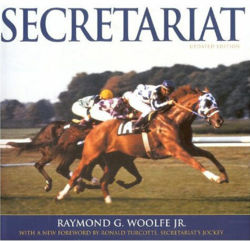
Sired by Bold Ruler out of the dam Somethingroyal, Secretariat was born at Meadow Farm in Caroline County, Virginia. Owned by Penny Chenery, he was trained by Canadian Lucien Laurin and ridden by fellow Canadian jockey Ron Turcotte. Secretariat won the 1973 Kentucky Derby, Preakness Stakes, and Belmont Stakes, making him the first Triple Crown winner in a quarter of a century.
Background
The story of Secretariat began with the toss of a coin in 1968 between Christopher Chenery of Meadow Stables and Ogden Phipps of Wheatley Stable. The idea of a coin toss came from Phipps, the owner of Bold Ruler, and Bull Hancock of Claiborne Farms as a way to get the very best mares for Bold Ruler, and when the toss went their way, to add well-bred fillies to their own broodmare band. Bold Ruler was considered one of the important stallions of his time. He had a fine balance between speed and stamina. After his racing career, Bold Ruler was retired to Claiborne Farms but still was controlled by the Phipps family. This meant he would be bred to mainly Phipps' mares and not many of his offspring would find their way to the auction ring. Phipps and Hancock agreed to forgo a stud fee for Bold Ruler in exchange for getting to keep one of two foals produced by the mare he bred in successive seasons or two mares he bred in the same season. Who obtained which foal or even received first pick would be decided by a flip of a coin.
In 1968, Chenery sent two mares named Hasty Matelda and Somethingroyal to Bold Ruler, and in 1969, a colt and filly were the result. In 1969, Hasty Matelda was replaced by Cicada, but she did not conceive. Only one foal resulted between Bold Ruler and Somethingroyal. As stated in the original agreement, the winner of the coin toss could pick the foal he wanted but could only take one, while the loser would get the other two. Both parties assumed Somethingroyal would deliver a healthy foal in the spring of 1970. The coin toss between Penny Chenery and Ogden Phipps was set for the fall of 1969 in the office of New York Racing Association Chairman Alfred Vanderbilt II, with Hancock as witness. As Vanderbilt flipped the coin, Phipps called "Tails!" The coin landed tails up. Phipps decided to take the weanling filly out of Somethingroyal, leaving Chenery with the colt out of Hasty Matelda and the unborn foal of Somethingroyal.
On March 30, just ten minutes past midnight, Somethingroyal foaled a bright red chestnut colt with three white socks and a star with a narrow blaze. Almost immediately, the colt was thought to be too pretty, a title that would haunt him early in his racing career and then earn him fame for his beauty as a Triple Crown winner. By the time the colt was a yearling, he still was without a name. Meadow's secretary, Elizabeth Ham, had submitted ten names to the Jockey Club, and all ten were denied for one reason or another. Approval finally came with the eleventh submission, a name Ham herself picked from a previous career association, Secretariat.
The Triple Crown
The Kentucky Derby
Nicknamed Big Red (as he was a large chestnut horse like Man o' War), he won the Kentucky Derby by gradually moving up on the field in the backstretch, then overtaking rival Sham in the middle of the dash for home. Making Secretariat's Derby win more impressive is that Sham's time of 1:59 4/5 equals Monarchos' 2001 Derby time, the second fastest in history.
A lesser-known but perhaps more amazing accomplishment of his, took place in that year's Derby. On his way to a still-standing record time in that race (1:59 2/5), he achieved the unheard-of feat of "negative splitting," running each quarter-mile (402 m) segment faster than the one before it. The successive quarter-mile times were: 25 1/5, 24, 23 4/5, 23 2/5 and 23.
The Preakness Stakes
Secretariat did not wait long to make his presence known in the Preakness. In last place as the horses moved past the stands, Big Red made a big leap forward on the first turn. CBS Television sportscaster Chic Anderson:
But HERE comes Secretariat, he's moving fast, and he's going to the outside - he's going for the lead and it's right NOW he's looking for it!
Despite constant left-handed whipping by jockey Laffit Pincay, Jr., Sham could not overtake Secretariat, who won by two and a half lengths. The main controversy of the race was its time. The infield totalisator board flashed a time of 1:55. The track's electronic timer malfunctioned because of damage from the huge crowd crossing the track to reach the infield. The Pimlico clocker, E.T. McLean Jr., who sheepishly admitted years later that he had in fact delayed clicking his stopwatch accurately as he too was transfixed on Secretariat's amazing performance (Source: Secretariat - Raymond G. Woolfe), had informed them that he had clocked a time of 1:54 2/5, while at the same time two Daily Racing Form clockers claimed the time was 1:53 2/5 which would have been faster than the track record (1:54 by Cañonero II). Two tapes of the horses were played side by side and were reclocked and slowly examined and Secretariat got to the finish line first on tape, though this is not a reliable method of timing a horse race. The Maryland Jockey Club, which managed the Pimlico racetrack and is responsible for maintaining Preakness records, discarded both electronic and The DRF time and recognized 1:54 2/5 as the official time. In some programs, both DRF and official time are printed. The official Preakness record book maintains that the time was 1:54 2/5, and Pimlico officials have chosen not to revisit this issue. In the interim, Tank's Prospect (1985), Louis Quatorze (1996), and Curlin (2007) have all run 1:53 2/5, equalling the time attributed to Secretariat by the Racing Form. Farma Way won the 1991 Pimlico Special in 1:52 2/5, setting the current track record. Oddly enough, Secretariat's stablemate Riva Ridge also ran the same distance in 1:52 2/5 in the 1973 Brooklyn Handicap at Aqueduct, sharing the current American dirt record at that distance with Farma Way. The issue of Secretariat's time in the Preakness may never be finally resolved.
The Belmont Stakes
Secretariat's statue at Belmont Park. Only four horses joined Secretariat for the June 9, 1973, running of the Belmont Stakes, including Sham, who had finished second in both the Derby and Preakness. With so few horses in the race, and with Secretariat expected to win, no "show" bets were taken. Before a crowd of 67,605, Secretariat and Sham set a blistering early pace, opening a 10-length cushion on the others. But while Sham faded after the halfway mark (ultimately finishing last), Secretariat astonished spectators by picking up the killing pace - eventually straining the television cameras' wide-angle capability as they struggled to keep the distant challengers in the same frame. Turcotte has said in documentaries that he could sense the horse wanted to be let loose, and he did so, letting the horse shift into "high gear" and run his own race.
In one of the best-known of American sports calls, Anderson - later Belmont Park's track announcer - punctuated Secretariat's powerful move on the final turn of the Belmont this way:
"...Secretariat is blazing along! The first three-quarters of a mile in 1:09 and four fifths. Secretariat is widening now! He is moving like a TREMENDOUS machine! Secretariat by 12, Secretariat by 14 lengths on the turn! Sham is dropping back. It looks like they'll catch him today, as My Gallant and Twice a Prince are both coming up to him now. But Secretariat is all alone! He's out there almost a 16th of a mile away from the rest of the horses! Secretariat is in a position that seems impossible to catch. He's into the stretch. Secretariat leads this field by 18 lengths, and now Twice a Prince has taken second and My Gallant has moved back to third. They're in the stretch. Secretariat has opened a 22-length lead! He is going to be the Triple Crown winner! Here comes Secretariat to the wire. An unbelievable, an amazing performance! He hits the finish 25 lengths in front!"
In fact, the champion's winning margin was 31 lengths - a distance it took careful examination of videotape and trackside photographs to measure, although veteran Daily Racing Form trackman Jack Wilson accurately recorded it as Secretariat hit the wire. Secretariat's time of 2 minutes and 24 seconds flat has remained the world record on dirt at that distance; no horse has come within 1 2/5 seconds of the time. During Anderson's call of the stretch run, the CBS camera had to pull back to keep both Big Red and his opponents in the frame, and as a result caught a poignant image in TV sports history - the backs of tens of thousands of cheering Belmont Park spectators cheering and applauding as Secretariat neared the wire. Almost as iconic as the still and video images of Secretariat blowing away the competition was the scene of owner Penny Chenery Tweedy waving her arms in exultation (and relief) in the Belmont owners' boxes. Anderson:
An amazing, unbelievable performance by this miracle horse - and look at Mrs. Tweedy! (laughing) She's having the time of her life!
Secretariat's stride at the finish was so powerful that it took jockey Ron Turcotte nearly two furlongs to pull him up. In fact, after Secretariat galloped out for 1/8 mile after the race his time for 1 and 5/8 miles including the cool down is alleged to be 2 minutes 37.6 seconds, which would have broken a world record set by the great Swaps in 1956 by three lengths. At the mile and 3/8 point, Secretariat had run faster than Man o' War's record from when the Belmont was run at that length. Secretariat's winning margin of 31 lengths in the long and grueling Belmont Stakes is remembered as one of the most dramatic events in thoroughbred racing history. Time Magazine, Newsweek, and Sports Illustrated featured Secretariat on their covers on June 11, 1973, the first to be featured on all three magazines' covers in the same week, though no journalists or racing experts had expected the pure and absolute domination that Secretariat exhibited. If the Beyer Speed Figure calculation had been developed during that time, Andrew Beyer calculated that Secretariat would have earned a figure of 139, one of the highest figures he has ever assigned. Bettors holding 5,617 winning on-course Tote tickets never redeemed them.
Interesting Notes
In contrast to most other great racehorses, with the notable exception of Man o' War, Secretariat never raced past age 3. His owner had promised breeding syndicators that he would retire after his 3 year old season. Unfortunately, this decision denied racing fans the opportunity to see him compete through a full season against open competition in handicap races under heavier weights and take on challengers on the harder tracks in the western United States. This comparatively early retirement is often cited by those who advocate other racehorses for the mythical "greatest ever" label.
In the fall of 1989, Secretariat was afflicted with laminitis, a painful and often incurable hoof condition. His condition failed to improve, and he was euthanized on October 4. He is buried at Claiborne Farm in Paris, Kentucky. In death, he received the ultimate honor for a horse - he was buried whole. By tradition, the only parts of a Thoroughbred buried at a gravesite are their head (to symbolize intelligence), heart (to symbolize strength), and legs (to symbolize power). Other parts are disposed of by other means.
Before his burial, he was necropsied at the University of Kentucky; Dr. Thomas Swerczek, the veterinarian who performed the necropsy, claims that he found that Secretariat's heart was the largest he had ever seen in a horse - approximately twice the size of a normal horse's heart. Dr. Swerczek states in correspondence:
"Certainly, after performing autopsies on several thousand thoroughbred horses, including mares and stallions, no other horse came close to Secretariat's heart size. The second largest heart I found was the heart of Sham, who actually broke the Kentucky derby record, but still lost to Secretariat. Sham's heart weighed 19 pounds. The third largest heart I found was stallion Key to the Mint, which was 16 pounds. The majority of all others were smaller, in the range of 10 to 12 pounds. Bold Ruler, the sire of Secretariat had an average size heart. The heart size seemingly is inherited from the female side of the pedigree. When I performed the autopsy on Secretariat, which was necessary because of insurance and we needed to determine the cause of the laminitis, the cause of destruction, I did a cosmetic autopsy. The reason being I did not want to dismantle such a remarkable specimen and the farm personnel and handlers were present to immediately collect all organs in large plastic bags which were immediately returned to the farm to be buried with the body. Normally, with other horses we can keep all organs and the body for further study, or to preserve large specimens, like the heart, but I was not allowed to do this with Secretariat. For this reason, all specimens were immediately collected and returned to the farm, and I did not get a chance to weigh the heart. However, by comparing it to numerous other hearts I got actual weights on, I am certain the weight was between 21 to 22 pounds. So I considered the heart weight officially as 21 pounds. The heart was in perfect shape, not diseased in any way, but just considerably larger than any other horses I autopsied."
A normal heart size for a thoroughbred is 8 1/2 pounds.
Top Home
Ruffian
 Ruffian Ruffian
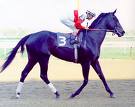  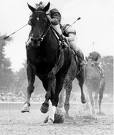
Sire Reviewer
Grandsire Bold Ruler
Dam Shenanigans
Damsire Native Dancer
Sex Filly. Foaled 1972, Country USA
Color Dark Bay
Breeder Stuart &Barbara Janney
Owner Stuart & Barbara Janney
Trainer Frank Whiteley, Jr.
Record 11:10-0-0
Earnings $313,428
Major Racing Wins
Astoria Stakes (1974)
Spinaway Stakes (1974)
Acorn Stakes (1975)
Mother Goose Stakes (1975)
Coaching Club American Oaks (1975)
Racing Awards
U.S. Champion 2-Yr-Old Filly (1974)
4th U.S. Triple Tiara Champion (1975)
U.S. Champion 3-Yr-Old- Filly (1975)
Honors
U.S. Racing Hall of Fame (1976)
#35 - Top 100 U.S. Racehorses of the 20th Century
Ruffian Handicap at Belmont Park
TV Film: Ruffian (2007)
Ruffian (April 17, 1972 - July 7, 1975) was an American champion thoroughbred racehorse, considered to be one of the greatest female racehorses of all time.
A dark bay, almost coal black filly, Ruffian was foaled at Claiborne Farm, near Paris, Kentucky. She was bred by Stuart S. Janney, Jr. and Barbara Phipps Janney, owners of Locust Hill Farm in Glyndon, Maryland. Ruffian was sired by the Phipps family's Bold Ruler stallion, Reviewer, and out of the Native Dancer mare Shenanigans. As a yearling and 2-year old, Ruffian was trained by Frank Y. Whiteley, Jr..
She earned the nickname "Queen of the Fillies" after being voted the Eclipse Award for Outstanding Two-Year-Old Filly in 1974 and winning the Filly Triple Crown (now called the Triple Tiara) in 1975. Lucien Laurin, Secretariat's trainer, even remarked to the press once that "she may be even better than Secretariat." Ruffian was undefeated in her first ten races, covering distances from 5.5 furlongs (1.1 km) to 1.5 miles (2.4 km) with an average winning margin of 8 1/3 lengths. She won her maiden race in record time and by 15 lengths.
Her 11th and final race, run at Belmont Park on July 6, 1975, was a match race between Ruffian and that year's Kentucky Derby winner, Foolish Pleasure. The two horses shared the same jockey, Jacinto Vasquez. Vasquez chose to ride Ruffian in the match race, believing her to be the better of the two horses. The "equine battle of the sexes" was heavily anticipated and attended by more than 50,000 spectators, with an estimated television audience of 18 million.
Just as the starting bell sounded and the race began, Ruffian hit her shoulder extremely hard on the starting gate. She recovered quickly, but was obviously in pain and leaning more heavily on her right foreleg compensating for the pain. The first quarter-mile (402 m) was run in a blazing 22 1/5 seconds, with Ruffian ahead by a nose. Little more than a 1 furlong (201 m) later, Ruffian was in front by half a length when both sesamoid bones in her right foreleg snapped. Vasquez tried to pull her up, but the filly wouldn't stop. She kept on running, pulverizing her sesamoids, ripping the skin of her fetlock as the bones burst through, driving the open wound into the sting sand of the Belmont track, tearing her ligaments, until her hoof was flopping uselessly, bent up like the tip of a ski. She was known for her incredible love of running and unwillingness to lose. She had never before been behind in a race.
She was immediately attended to by a team of four veterinarians and an orthopedic surgeon, and underwent an emergency operation lasting 3 hours. Tragically, when the anesthesia wore off after the surgery, she thrashed about wildly on the floor of a padded recovery stall as if still running in the race. Despite the efforts of numerous attendants, she began spinning in circles on the floor. As she flailed about with her legs, she repeatedly knocked the heavy plaster cast against her own elbow until the elbow, too, was smashed to bits. The cast slipped, and as it became dislodged it ripped open her foreleg all over again, undoing what good, if any, the surgery had done. The medical team, knowing that she would probably not survive more extensive surgery for the repair of her leg and elbow, euthanized her shortly afterwards.
Her performance in the 1975 season earned her the Eclipse Award for Outstanding Three-Year-Old Filly. In 1976, she was inducted into the National Museum of Racing and Hall of Fame. No match race has taken place at Belmont since Ruffian's death.
Her breakdown and tragic death led to a public outcry for more humane treatment of racehorses. As it is natural for horses to thrash and kick when coming out of anesthesia, a "recovery pool" was developed so that they awake suspended in warm water and don't re-injure themselves. Medications such as Lasix for bleeding and corticosteroids for inflammation and pain management, came into common use. While helping the horses in the short term, the increased use of medications at the track had a downside, as many more horses were raced while injured. It can be argued that thoroughbreds have become more delicate as a result of inbreeding, starting racing too young, and racing while injured; racehorses today run only half as many starts before retirement as did their counterparts 50 years ago. Some of this effect is likely also due to breeding practices that select for horses likely to have short, brilliant careers-like Ruffian's-instead of the traditional racing career which might have lasted several years. Indeed, Ruffian's bloodline may be considered at least partly to blame for her broken leg; her sire, Reviewer, suffered three breakdowns.
Regardless, Ruffian herself may be regarded as one of racing's best and brightest. The Blood-Horse ranked Ruffian 35th in its list of the top 100 U.S. thoroughbred champions of the 20th Century. Sports Illustrated included her as the only non-human on their list of the top 100 female athletes of the century, ranking her 53rd.
Ruffian is buried near a flag pole in the infield of Belmont Park. When she was alive, her trainer always put her in one of his old blankets, but when she was buried, he buried her in two of his good blankets, because she deserved them. She was buried facing toward the finish line.
Top Home
Seattle Slew
 Seattle Slew Seattle Slew
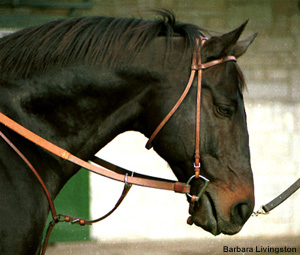  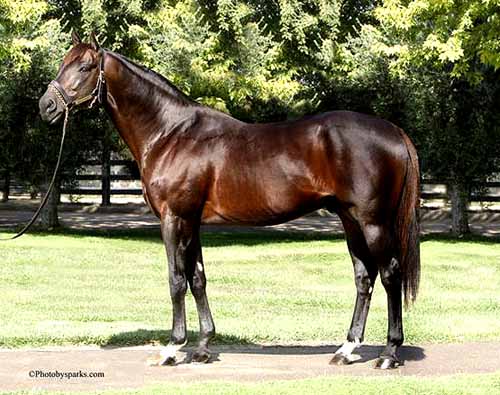
Sire Bold Reasoning
Grandsire Boldnesian
Dam My Charmer
Damsire Poker
Sex Stallion, Foaled 1974, Country United States
Colour Brown
Breeder Ben S. Castleman
Owner Karen & Mickey Taylor. Racing silks: Black, yellow yolk, yellow hoops on sleeves, yellow cap, black pompom.
Trainer Billy Turner
Douglas R. Peterson
Record 17:14-2-0
Earnings $1,208,726
Major Racing Wins, Awards and Honors
Major Racing Wins
Champagne Stakes (1976)
Wood Memorial Stakes (1977)
Kentucky Derby (1977)
Preakness Stakes (1977)
Belmont Stakes (1977)
Woodward Stakes(1978)
Marlboro Cup (1978)
Stuyvesant Handicap(1978)
Flamingo Stakes (1977)
Racing Awards
10th U.S. Triple Crown Champion (1977)
U.S. Champion 2-Yr-Old Colt (1976)
U.S. Champion 3-Yr-Old Colt (1977)
Eclipse Award for Horse of the Year (1977)
U.S. Champion Older Male Horse (1978)
North American leading broodmare sire (1995, 1996)
Blood-Horse magazine List of the Top 100 U.S. Racehorses of the 20th Century
NTRA "Moment of the Year" (2002)
Honors
National Museum of Racing and Hall of Fame (1981)
Infobox last updated on: September 16, 2006.
Seattle Slew (February 15, 1974 - May 7, 2002) was an American thoroughbred race horse who won the Triple Crown of Thoroughbred Racing in 1977, the tenth of eleven horses to accomplish the feat. He remains the only horse to win the Triple Crown while undefeated. In the Blood-Horse magazine List of Top 100 Racehorses of the 20th Century, Seattle Slew is ranked ninth.
By Bold Reasoning out of My Charmer, he was foaled at Ben Castleman's White Horse Acres Farm near Lexington, Kentucky. Not expected to be a great racehorse, he was sold to Karen and Mickey Taylor of White Swan, Washington. They named him for the city of Seattle, and for the sloughs loggers once used to transport heavy logs. But Karen felt that the spelling of slough-a slow-moving channel of the Pacific Northwest-would be too hard for people to remember, so the spelling was changed to Slew. The colt's co-owners were Jim and Sally Hill. Another co-owner was Glenn Rasmussen, the Certified Public Accountant for the horse partnerships.
As A 2 Year Old
Slew began his career on September 20, 1976 in the fifth race at Belmont Park on Long Island, New York, a six furlong maiden race. He was a big, nearly black two year old, and was bet down to the 5-2 favorite. He gave the public its first look at what his fans would later call a "War Dance," his habit of tiptoeing on the track before his races, and won by five lengths. Seattle Slew started only two more times as a two-year-old, winning an allowance race by 3 1/2 lengths on October 5, 1976, and the Champagne Stakes 11 days later by 9 3/4 lengths in a fast 1:34 2/5. Despite starting just three times, Seattle Slew was named the Champion 2 year old of 1976.
Preparing for the Triple Crown
Billy Turner, Slew's trainer, waited to start Seattle Slew as a three-year-old until March 9, 1977, when he won an allowance race by nine lengths at Hialeah in track record time for seven furlongs. On March 26, 1977, Seattle Slew won the Flamingo Stakes by four lengths in the third fastest time in stakes history.
Seattle Slew then added the Wood Memorial Stakes on April 23, 1977 by 3 1/4 lengths, in his final prep for the Kentucky Derby.
Triple Crown
Seattle Slew went off as the prohibitive 1-to-2 favorite in the Kentucky Derby on May 7, 1977. Seattle Slew was a speed horse who normally broke well and went right to the lead, but in the Derby, he swerved and was taken up by jockey Jean Cruguet. However, Cruguet and Seattle Slew were able to recover and get to the lead. Seattle Slew dueled with For the Moment for the first mile of the race. At the top of the stretch, Seattle Slew pulled away to win by 1 3333/4 lengths over Run Dusty Run.
Two weeks later, in the Preakness Stakes, Seattle Slew faced a new rival, multiple stakes winner Cormorant. Many handicappers believed the likely speed duel with Cormorant would jeopardize Slew's chances; Andrew Beyer picked Cormorant to win in his Washington Post column. Seattle Slew outlasted Cormorant and held off Iron Constitution to win by 1 1/2 lengths.
The Belmont Stakes was an easy coronation for Seattle Slew, who won by four lengths. He became the tenth American Triple Crown Winner and, with his 9 for 9 record, the first Triple Crown winner to finish the series undefeated.
After the Triple Crown
After the Triple Crown, Seattle Slew was sent to Hollywood Park Racetrack, who offered a $400,000 purse to entice Seattle Slew to compete in the Swaps Stakes on July 3, 1977.
In the Swaps, Seattle Slew, who normally broke on the lead, was unable to get to the front, as Bill Shoemaker sent J.O. Tobin, whom Seattle Slew had easily beaten in the Preakness, to the lead. J.O. Tobin set very fast fractions for a 1 1/4 mile race, running 22 2/5 to the 1/4 mile, 45 2/5 to the 1/2 mile, 1:09 1/5 to the 3/4 mile, and 1:33 3/5 to the mile. Seattle Slew was not able to keep up, and tired badly in the stretch, finishing fourth, 16 lengths behind J.O. Tobin, who won by 8 lengths in 1:58 3/5, just 2/5 of a second off the American record for the distance at the time. After this loss, rest and physical problems would ultimately keep Seattle Slew away from the races for almost a year.
Despite the season ending loss, Seattle Slew was honored at year's end as champion three-year-old and the Eclipse Award for Horse of the Year.
1978
In early 1978, Seattle Slew was stabled at Hialeah and was expected to make three starts in Florida before contesting the Metropolitan Mile in New York. In Florida, the horse, who had recovered from his cough as a three year old, took a turn for the worse in January 1978. He stopped eating and sometimes broke into sweats, which lasted for hours. At times, he fell when he tried to stand. Hill diagnosed a viral infection and feared Slew might die.
Slew recovered slowly. When he finally made it back to the races on a sloppy track at Aqueduct in May, Seattle Slew had a new trainer, Douglas Peterson, who replaced Turner.
Slew won that allowance race at Aqueduct easily, by eight and a half lengths on a sloppy surface, and later another seven furlong allowance race by six lengths at Saratoga Race Course in August. In preparation for a heralded matchup against the 1978 Triple Crown winner Affirmed, Seattle Slew was sent to the Meadowlands for a night time race, the Paterson Handicap. Slew narrowly lost to Dr. Patches in a major upset. Cruguet lost the mount after that race, after expressing doubt the horse was trained sufficiently for the race.
In the Marlboro Cup, the first ever matchup of two Triple Crown winners, Seattle Slew was not the favorite, for the first and only time of his career. Angel Cordero, Jr. took the reins as Slew's new jockey. Affirmed was the 1-2 favorite. Seattle Slew was the 2-1 second choice. Affirmed's arch rival, Alydar, was scheduled to run and scratched the week before the race.
Affirmed and Seattle Slew were both speed horses. Seattle Slew broke first and stayed there into the homestretch. Cordero took Slew somewhat wide off the final turn and Affirmed came up on on him for a moment, but Seattle Slew opened up again to beat Affirmed by three lengths in the excellent time of 1:45 4/5 for a mile and an eighth, 2/5 of a second off the track record set by Secretariat.
Two weeks later, Slew easily won the Woodward Stakes over Exceller by four lengths at a mile and a quarter.
The '78 Jockey Club Gold Cup
Then, in October, Slew and Affirmed met again at the mile and a half Jockey Club Gold Cup at Belmont, a showdown televised nationally on CBS. Affirmed's trainer, Laz Barrera, didn't want Seattle Slew to get an easy lead and dictate the pace like the Marlboro Cup, so Barrera entered a "rabbit" named Life's Hope in an attempt to tire Seattle Slew.
Barrera's plan was compromised when Seattle Slew and Affirmed took off along with Life's Hope. Seattle Slew pulled away from Affirmed and Life's Hope, and Affirmed's saddle then slipped, eliminating him from contention (he would finish 5th). Seattle Slew ran 22 3/5 to the first quarter, 45 1/5 to the half, and 1:09 2/5 to the 3/4 mile, virtually unheard of going a mile and a half.
However, sitting far back, Willie Shoemaker, riding Exceller, was able to take advantage of the fast, tiring pace. Exceller made a strong move on the far turn, and then was able to save ground by moving inside of Seattle Slew as Seattle Slew bore out turning for home. Exceller got the lead at the top of the stretch, but Seattle Slew gamely fought back and lost by a nose in a photo finish.
This stretch drive is still recalled by many to be among the all-time best-ranking with Sunday Silence and Easy Goer's Preakness in 1989 and the battles between Affirmed and Alydar. Despite the defeat, many analysts called this Seattle Slew's greatest performance. Andrew Beyer, always a Seattle Slew skeptic as a three-year-old, wrote for his lead; "Exceller won Saturday's Jockey Club Gold Cup. Seattle Slew was its hero."
Seattle Slew's Final Race
Seattle Slew's last race was an easy victory in the Stuyvesant Handicap in November at Aqueduct Racetrack, by three and a quarter lengths while carrying 134 pounds.
Seattle Slew retired with 14 wins in 17 races and earnings of $1,208,726. He was named Champion Older Horse in 1978, but lost the Horse of the Year balloting to the horse he handily defeated twice, Affirmed. He was elected to the National Museum of Racing and Hall of Fame in 1981.
Retirement
In retirement, Seattle Slew stood at stud at the Three Chimneys Farm in Midway, Kentucky. Slew was the leading sire of 1984, when his son Swale, who died later that year, won the Kentucky Derby and Belmont Stakes. His other best progeny include the talented, but ill-fated 1982 champion two-year-old filly, Landaluce, Slew o'Gold, winner of the 1983 Eclipse Award for Outstanding Three-Year-Old Male Horse and the 1984 Eclipse Award for Outstanding Older Male Horse, the 1992 Horse of the Year A.P. Indy, sire of 2006 Preakness Stakes winner Bernardini, 2000 champion three-year-old filly Surfside, and 2007 Belmont Stakes winner Rags to Riches. He is also the only Belmont Stakes winner to sire a Belmont Stakes winner (A.P. Indy) who then in-turn sired a Belmont Stakes winner (Rags to Riches).
Legacy
A primary conduit for Seattle Slew's continuation of his male line has been through A.P. Indy. A.P. Indy has done very well at stud in Kentucky, getting, among others, the 2003 Horse of the Year Mineshaft. Currently, one of Seattle Slew's most successful grandsons is the California champion Lava Man, sired by Slew City Slew. In 2006, Lava Man became the first horse to win the Santa Anita Handicap, Hollywood Gold Cup, and Pacific Classic Stakes in the same year. Seattle Slew was also a leading broodmare sire, his daughters producing, among others, the all-time leading money earning American Thoroughbred, Cigar.
Races in honor of his dam, My Charmer, include the My Charmer Handicap held at Florida's Calder Race Course each year, and the My Charmer Stakes held at Kentucky's Turfway Park.
Rags to Riches, a granddaughter, won the 2007 Belmont Stakes, the third filly to win the race following Ruthless in 1867 and Tanya in 1905. The win earned jockey John Velazquez and trainer Todd Pletcher their first wins in any Triple Crown race. Rags To Riches was the 22nd filly to ever run in the Belmont.
Seattle Slew is buried at Hill 'n'- Dale Farms near Lexington, Kentucky.
Top Home
Affirmed
 Affirmed Affirmed
 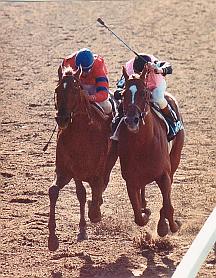
Affirmed (February 21, 1975 - January 12, 2001) was an American thoroughbred race horse who was the eleventh winner of the Triple Crown of Thoroughbred Racing. As of 2007, he was the last horse to do so. He was the great-great-grandson of Triple Crown winner War Admiral through damsire Crafty Admiral.
Affirmed is also known for his famous rivalry with Alydar, whom Affirmed met ten times, including in all three Triple Crown races, and who became the first racehorse to finish second in all three Triple Crown races.
Race Record At Age 2
As a 2 year old, Affirmed won 7 of 9 starts with two place finishes for earnings of $343,477 under regular rider Steve Cauthen, then a teenager. Notably, six of those starts were against his rival, Calumet Farm's Alydar, with Affirmed winning four and Alydar winning two. Affirmed had a front-running style and Alydar closed from far back, so their races together often consisted of Affirmed getting the lead and Alydar attempting to catch him late in the race. After Affirmed won a maiden race, he faced Alydar (who was ambitiously placed by trainer John M. Veitch in a stakes race in his first start) for the first time in the Youthful Stakes, a 5 1/2 furlong stakes in June at Belmont Park. Affirmed won the race by a nose, and Alydar finished a distant fifth. It was the only time that the horses would meet where they would not run 1-2.
Their second meeting came in July 1977 in the Great American Stakes at 6 1/2 furlongs. This time, Alydar would turn the tables, blowing by Affirmed at the top of the stretch and drawing away to win by 3 1/2 lengths. Affirmed also picked up a win in California's major summer stakes for 2 year olds, the Hollywood Juvenile Championship, before shipping back east to face Alydar again.
The colts then moved on to Saratoga Race Course, where they ran in the Hopeful Stakes, a major 2 year old stakes race held each August. Affirmed held off Alydar's charge to win by 3/4 of a length. By this time, the colts were starting to arouse interest and press coverage, as they seemed to be relatively evenly matched and were the two best 2 year old colts in the country. Affirmed also picked up a victory in the Sanford Stakes at Saratoga, a race that Alydar sat out.
The colts met again in the Futurity Stakes at Belmont Park in September. This time Alydar moved earlier. The colts hooked up with 3/8 of a mile to go, and battled in an exciting duel to the wire. Affirmed won by a nose, giving the colt a 3-1 edge in the series.
Still, Alydar's partisans believed his come-from-behind style would favor the horse at longer distances. The Champagne Stakes in October, which often decided the 2 year old championship in that era, seemed to prove Alydar's fans right. The Champagne was run at a mile, and this time, Alydar moved late, making up ground in the final 1/8 of a mile to pass Affirmed near the wire and win by more than a length. Alydar's win the Champagne might have wrapped the 2 year old championship up for the colt, but Affirmed would have one more chance, in the Laurel Futurity in November. Affirmed and Alydar both made their moves on the turn, hooked up in another duel like the one in the Futurity Stakes, with the same result, Affirmed winning, this time by a neck.
With his 4-2 margin in the series, Affirmed was named the Champion 2 year old of 1977.
Preparing for the Triple Crown
Trainer Laz Barrera decided he didn't want to continue facing Alydar when preparing for the Triple Crown. So, while Alydar shipped to Florida and then to Kentucky to prepare for the Kentucky Derby, Affirmed came back to Santa Anita in California. He picked up a win in the San Felipe Stakes, and then won the major preparation race for the Kentucky Derby, the Santa Anita Derby, by a distance. His last Kentucky Derby prep would come with a victory in the Hollywood Derby at Hollywood Park.
With Affirmed and Alydar both winning their Derby preps easily, the 7th meeting of the colts in the Kentucky Derby would be eagerly anticipated.
The Triple Crown
In the Kentucky Derby, Affirmed let Sensitive Prince take the early lead, sitting third through the early stages, while Alydar stayed far back. Affirmed made a strong move for the lead on the far turn, and Alydar's move came too late in the stretch. Affirmed won by 1 1/2 lengths. Affirmed now had a 5-2 edge in the series.
In the Preakness, Affirmed went to the lead and set the pace, and Alydar made his big move on the far turn, at the same point in the race when Affirmed made his winning move in the Derby. Affirmed held a short lead entering the stretch and was able to hold it against Alydar's relentless drive. Affirmed held on and won by a neck.
As exciting as the Preakness was, the Belmont Stakes would turn out to be even more exciting. Again, Alydar's partisans assumed that the 1 1/2 mile distance of the Belmont, 1/4 of a mile longer than the Derby and 5/16 of a mile longer than the Preakness, would favor the colt with his closing style, and he would finally be vindicated and would deny Affirmed the Triple Crown.
However, Affirmed was able to get to the lead and set a very slow pace, going the first quarter mile in 25 seconds and the half in 50 seconds. Alydar's jockey, Jorge Velasquez, smartly put Alydar close to the pace, and moved alongside Affirmed with more than 6 furlongs to go. For more than 3/4 of a mile, the two colts raced neck and neck, pulling away from the rest of the field. At the finish line, once again, Alydar could not vanquish Affirmed, and Affirmed won by a nose and became racing's 11th Triple Crown winner.
After the Triple Crown
Affirmed returned to the races in early August in the Jim Dandy Stakes at Saratoga. Affirmed nearly became an upset loser himself to the front running Sensitive Prince but was able to close in the last 100 yards in a race that Laz Barrera considered one of Affirmed's finest efforts.
Affirmed and Alydar would meet once more, in the Travers Stakes at Saratoga. Affirmed, piloted by Hall of Fame Jockey Laffit Pincay who was substituting for the injured Cauthen, cut off Alydar entering the far turn causing his rival to check suddenly. Affirmed crossed under the wire first but was disqualified and placed second. They would never meet again, and the final standing stood at Affirmed 7, Alydar 3.
Affirmed then prepared to meet another major rival, the 1977 Triple Crown winner, Seattle Slew. The 1978 Marlboro Cup Invitational Handicap marked the first time in racing history that two Triple Crown winners ever met in a race. Seattle Slew, the 1977 champion, who was also a speed horse, never allowed Affirmed to get close to him and defeated Affirmed by three lengths. They would meet once more, in the Jockey Club Gold Cup. This time, Affirmed was to be aided by a rabbit, his stablemate Life's Hope, who was entered in the race was to push Seattle Slew to run very fast in the first stages of the race. However, Affirmed's saddle slipped during the race, leaving his jockey with almost no control. Affirmed tired and finished far back as Exceller and Willie Shoemaker beat Seattle Slew by a nose.
As a 3 year old, Affirmed won 8 of 11 starts with 2 seconds and 1 out of the money finish, for earnings of $901,541. He was named Horse of the Year despite the two losses to Seattle Slew, and was also named the Champion 3 year old.
As A 4 Year Old
As a four-year-old in 1979, Affirmed got off to a rocky start, with a third place finish in the Malibu Stakes and a second place finish in the San Fernando Stakes. He was thus carrying a five race losing streak into the Charles H. Strub Stakes at Santa Anita Park. Laz Barrera fired Cauthen and replaced him with Pincay. With Pincay aboard, Affirmed would never lose again and would dominate the handicap division the rest of the year, establishing that his dominance of Alydar was no fluke.
Affirmed won the Strub, and then ran in the Santa Anita Handicap against Exceller, the horse who had upset Seattle Slew in 1978. Affirmed won easily, setting the stakes record in California's most important stakes race which still stands as of 2008. Affirmed then went to Hollywood Park, where he won the Californian, and then, carrying 132 pounds, he won the Hollywood Gold Cup in a 3 horse stretch drive over Sirlad and Text, setting an all time earnings record and running the 1 1/4 miles in a fast 1:58 2/5. Affirmed picked up the Woodward Stakes at Belmont Park, and then faced one more all time great horse, 3 year old Spectacular Bid, in the Jockey Club Gold Cup, also at Belmont. Spectacular Bid, like Alydar, preferred to run off the pace, and once again, Affirmed was allowed to set a slow pace, going the first half mile in 49 seconds. Spectacular Bid made several runs at Affirmed, but could not get by, and Affirmed closed out his career by handing another great horse what would be the final defeat of his career, as Spectacular Bid would go on to have an undefeated season in 1980.
Affirmed was named Horse of the Year and Champion Older Horse of 1979, having won 7 of 9 starts with 1 second and 1 third as a 4 year old and earning $1,148,800. In his career, Affirmed earned a then record $2,393,818 (first thoroughbred racer in North America to win over 2 million dollars in a career) with 22 wins, 5 seconds and 1 third from 29 starts.
Affirmed's courage was in many ways his most remarkable attribute. Affirmed was a natural speed horse who won most of his races on or near the lead. However, when challenged in the stretch, even by top horses such as Alydar and Spectacular Bid, he simply would not let them pass. Affirmed therefore had a lethal combination of speed (which allowed him to get early position and not have to rely on a good trip passing horses to get into position and win) and heart (which allowed him to fend off challengers).
Affirmed's Triple Crown accomplishment has not been repeated since, and his career has been honored with his election to the National Museum of Racing and Hall of Fame.
Affirmed's trainer, Laz Barrera, once said: "Affirmed is greater than Secretariat, or any Triple Crown winner, because only Affirmed had to face Alydar."
Career As A Sire
Affirmed was syndicated at a then-record 14.4 million dollars. At stud Affirmed sired over 80 stakes winners, 9 champions with earnings in excess of $44,000,000 (through 2004) including Flawlessly and Peteski (Canadian triple crown winner in 1993). Though Affirmed never raced on the turf (grass) he was a noted sire of turf runners, most notably multiple Grade I winners Flawlessly and The Tin Man. His daughters are valued as broodmares.
Affirmed was the second US Triple Crown winner to sire a second generation Triple Crown champion. Affirmed's foal, Peteski, won the Canadian Triple Crown in 1993.
In 2001, Affirmed was euthanized after falling seriously ill with laminitis, a circulatory hoof disease. The same disease has also led to the death of fellow Triple Crown winner Secretariat and Kentucky Derby winner Barbaro. He was buried whole--the ultimate honor for a race horse--at Jonabell Farm, wearing the flamingo pink silks of his original owners, Harbor View Farm.
In the Blood-Horse magazine ranking of the top 100 U.S. thoroughbred champions of the 20th Century, Affirmed was ranked #12.
Sire Exclusive Native
Grandsire Raise a Native
Dam Won't Tell You
Damsire Crafty Admiral
Sex Stallion, Foaled 1975, Country United States
Colour Chestnut
Breeder Harbor View Farm
Owner Harbor View Farm. Silks: Flamingo, White Bars on Black Sleeves, Black Cap
Trainer Laz Barrera
Record 29: 22-5-1
Earnings $2,393,818
Major Racing Wins, Awards and Honours
Major Racing Wins
Futurity Stakes (1977)
Hopeful Stakes (1977)
Santa Anita Derby (1978)
Kentucky Derby (1978)
Preakness Stakes (1978)
Belmont Stakes (1978)
Hollywood Gold Cup (1979)
Santa Anita Handicap (1979)
Woodward Stakes (1979)
Jockey Club Gold Cup (1979)
Racing Awards
11th U.S. Triple Crown Champion (1978)
American Champion 2-Year-Old Colt (1977)
American Champion 3-Year-Old Male Horse (1978)
American Horse of the Year (1978, 1979)
Honors
United States Racing Hall of Fame (1980)
#12 - Top 100 U.S. Racehorses of the 20th Century
Affirmed Handicap at Hollywood Park Racetrack
Affirmed Street in Napa, California
Infobox last updated on: 20:29, Saturday June 7, 2008 (UTC).
Top Home
Silver
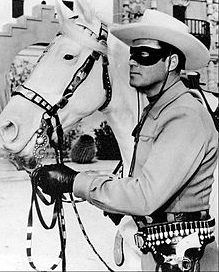 "The Lone Ranger is a fictional masked former Texas Ranger who fought outlaws in the American Old West with his native American friend, Tonto. The character has been called an enduring icon of American culture. He first appeared in 1933 in a radio show conceived either by WXYZ (Detroit) radio station owner George W. Trendle, or by Fran Striker, the show's writer. The character was originally believed to be inspired by Texas Ranger Captain John R. Hughes, to whom the book 'The Lone Star Ranger' by Zane Grey was dedicated in 1915. The radio series proved to be a hit and spawned a series of books (largely written by Striker), an equally popular television show that ran from 1949 to 1957, comic books, and several movies. The title character was played on the radio show by George Seaton, Earle Graser, and Brace Beemer. Clayton Moore acted the Lone Ranger on television, although during a contract dispute, Moore was replaced temporarily by John Hart, who wore a different style of mask. On the radio, Tonto was played by, among others, John Todd and Roland Parker; and in the television series, by Jay Silverheels, who was a Mohawk from the Six Nations Indian Reserve in Ontario, Canada....According to the episode 'The Legend of Silver' (September 30, 1938), before acquiring Silver, the Lone Ranger rode a chestnut mare called Dusty. The Lone Ranger saves Silver's life from an enraged buffalo and, in gratitude, Silver chooses to give up his wild life to carry him. "The Lone Ranger is a fictional masked former Texas Ranger who fought outlaws in the American Old West with his native American friend, Tonto. The character has been called an enduring icon of American culture. He first appeared in 1933 in a radio show conceived either by WXYZ (Detroit) radio station owner George W. Trendle, or by Fran Striker, the show's writer. The character was originally believed to be inspired by Texas Ranger Captain John R. Hughes, to whom the book 'The Lone Star Ranger' by Zane Grey was dedicated in 1915. The radio series proved to be a hit and spawned a series of books (largely written by Striker), an equally popular television show that ran from 1949 to 1957, comic books, and several movies. The title character was played on the radio show by George Seaton, Earle Graser, and Brace Beemer. Clayton Moore acted the Lone Ranger on television, although during a contract dispute, Moore was replaced temporarily by John Hart, who wore a different style of mask. On the radio, Tonto was played by, among others, John Todd and Roland Parker; and in the television series, by Jay Silverheels, who was a Mohawk from the Six Nations Indian Reserve in Ontario, Canada....According to the episode 'The Legend of Silver' (September 30, 1938), before acquiring Silver, the Lone Ranger rode a chestnut mare called Dusty. The Lone Ranger saves Silver's life from an enraged buffalo and, in gratitude, Silver chooses to give up his wild life to carry him.
The origin of Tonto's horse, Scout, is less clear. For a long time, Tonto rides a white horse called White Feller. In "Four Day Ride" (August 5, 1938), Tonto is given a paint horse by his friend Chief Thundercloud, who then takes White Feller. Tonto rides this horse and refers to him simply as "Paint Horse" for several episodes. The horse is finally named Scout in "Border Dope Smuggling" (September 2, 1938). In another episode, however, the Lone Ranger, in a surge of conscience, releases Silver back to the wild. The episode ends with Silver returning, bringing along a companion who becomes Tonto's horse Scout. In an echo of the Lone Ranger's line, Tonto frequently says, 'Git-um up, Scout!' (The phrase became so well embedded in the Lone Ranger mythos that International Harvester used it as an advertising line to promote their Scout utility vehicle in the 1970s.)..."
 Lone Ranger Lone Ranger 
Top Home
|
